Up is a collection of parts from Hans Wuethrich of Switzerland. Pulled from various wreck sites, these pieces include the pilot’s electrical panel, vacuum control, and the master switches to an early Sperry upper turret.
The Boeing B-17’s electrical panel was mounted on the wall by the pilot’s left leg, holding four E-1 ammeters and one B-1 voltmeter, along with a combination of toggle switches, rheostat, and five-way selector switch. The ammeters on this particular unit had been crudely replaced with unknown units at some point, suggesting that this panel came from a postwar aircraft, possibly a firefighter. There are some dents in the housing assembly and a break in the faceplate, but we are confident that it can all be restored.
Turret parts always seem to elude us so the top turret’s control panel was a pleasant surprise – particularly since it is a match for the Type A-1 needed for Lucky Thirteen.
Speaking of the A-1, our friend Dave of the B-17 Cockpit Project provided us with the references necessary to 3D model the top turret’s charging handles. The charging handles mounted to the turret’s dome and were connected to the guns via a pulley system. By pulling the handles, the gunner ‘charged’ his guns.
Dave’s reference material was given to volunteer Kevin Davenport, who teaches CAD engineering at Creekside High School in St. Johns, Florida. The part was then modeled by one of his teenage students and Kevin brought a 3D print of it to show at the Triple Tree fly-in. Special thanks to these guys for their work – we now have the ability to recreate this piece for Lucky Thirteen.
Last is a Type K-4 gunsight which was donated by Guy Evans of Visalia, California. The K-4 was an inverted version of the Sperry K-3 used in the upper turret, and both sights were unique to the B-17. The K-4 was used by the bomber’s ball turret. Guy’s K-4 was an older unit with a flat switch plate, so it is accurate to Lucky Thirteen. In fact, because the toggle switch is not radium tipped and the internal gears not color anodized, we suspect this sight was made somewhat early in production.
Unfortunately, while Guy’s K-4 was sent to us still on its original shipping mount, the side housing and glass lens were at some point lost in its past. If anyone can help us replace these parts, please let us know!
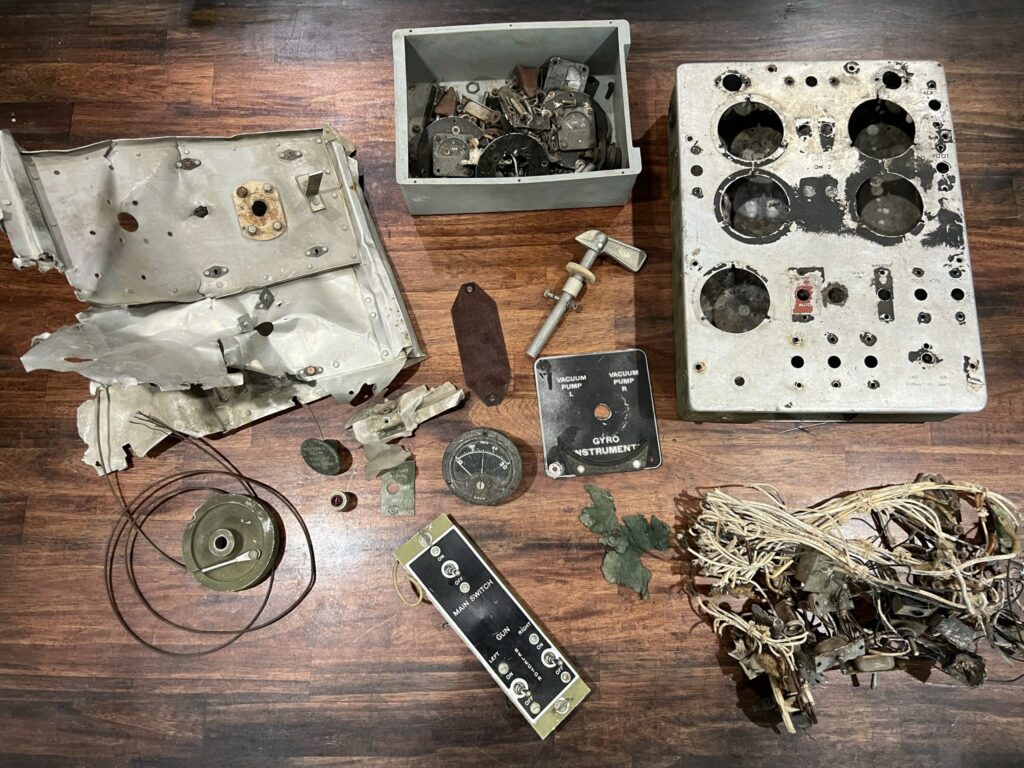
The newly arrived parts from Hans Wuethrich.
Photo taken 17 August 2023.

The B-17 electrical panel from Hans Wuethrich.
Photo taken 17 August 2023.
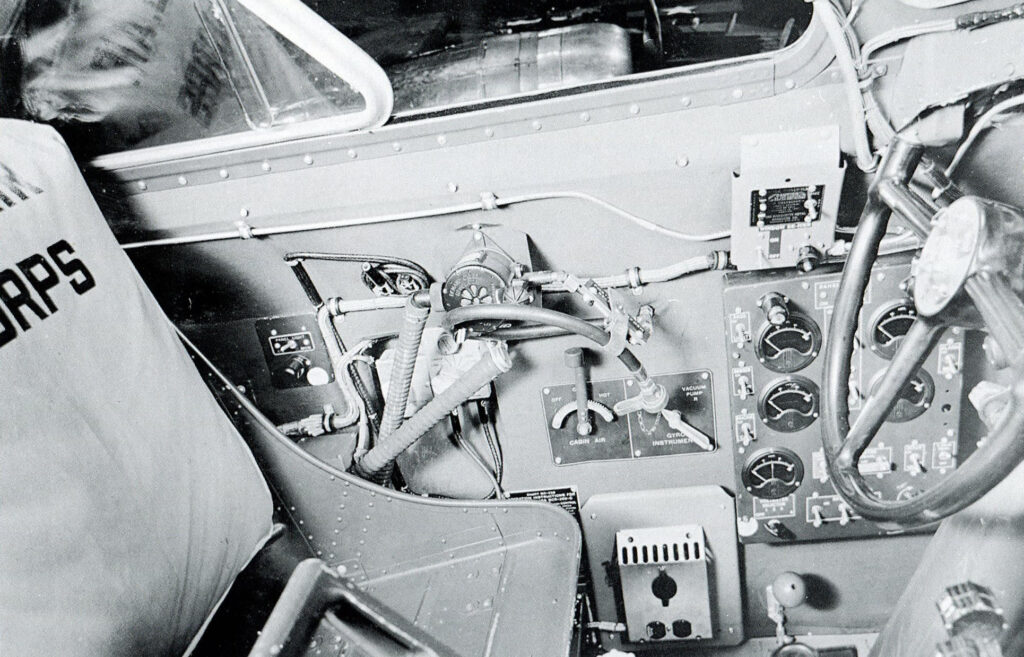
The left cockpit wall of Flak Dodger (42-29467). An F-model older than Lucky Thirteen but younger than Memphis Belle, Flak Dodger served with 99BG of the 12AF.
Note the pilot’s electrical panel on the far right. Unlike most instrument panels, the B-17’s electrics panel was painted the same bronze green as the cockpit itself.

The B-17 vacuum control from Hans Wuethrich.
Photo taken 17 August 2023.
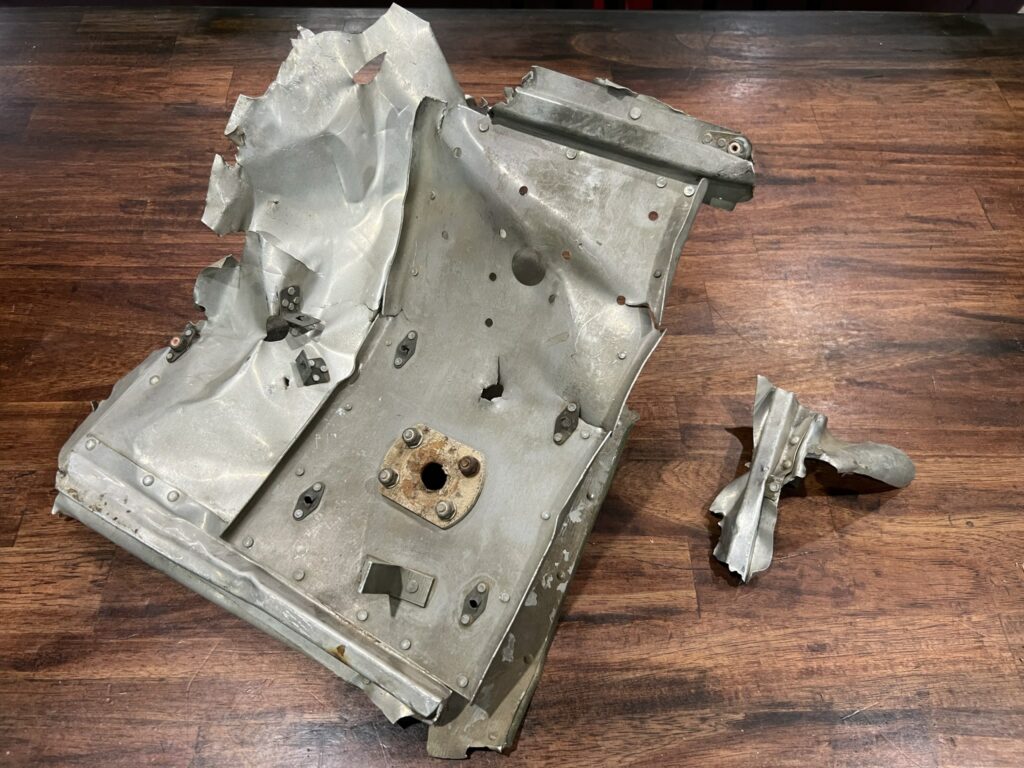
A large piece of B-17 wreckage from Hans Wuethrich.
Photo taken 17 August 2023.
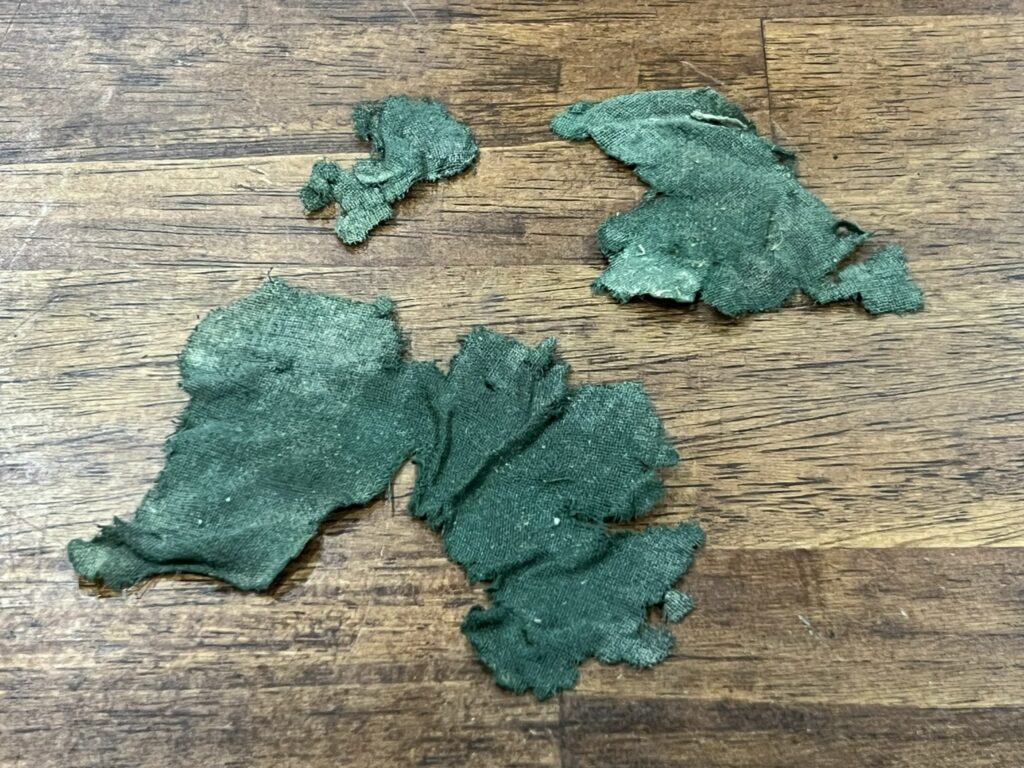
Pieces of bronze green fabric from Hans Wuethrich. This fabric was found in the nose, cockpit, and radio compartments of F-model B-17s like Lucky Thirteen.
On G-models, this fabric was only found in the cockpit.
Photo taken 17 August 2023.

Left cockpit wall photo of 42-30432, a B-17F which served with the 97BG in the 12AF.
The left cockpit wall of Lucky Thirteen was identical to what you see here.
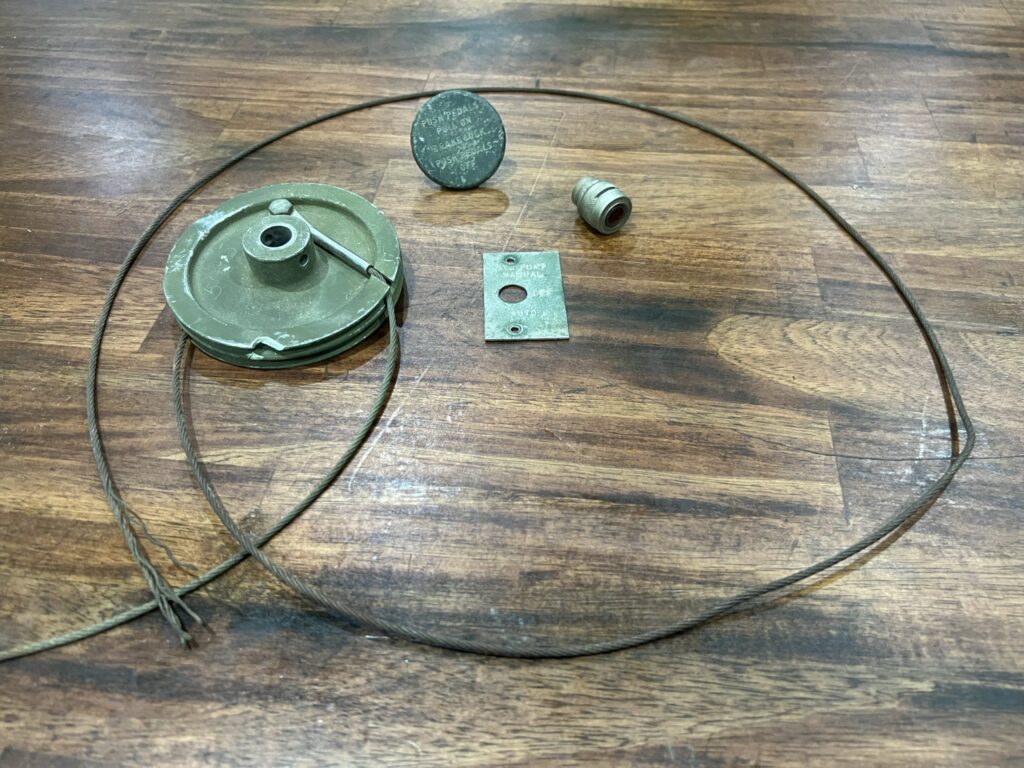
A B-17 pulley, dimmer light, switch plate, and brake handle from Hans Wuethrich.
Photo taken 17 August 2023.

The copilot’s panel to 42-30232, a B-17F which was converted to an F-9 reconnaissance aircraft for the 100BG (8AF). The co-pilot’s panel to Lucky Thirteen was identical to what you see here.
The parking brake is obscured by the white paper on the bottom right.
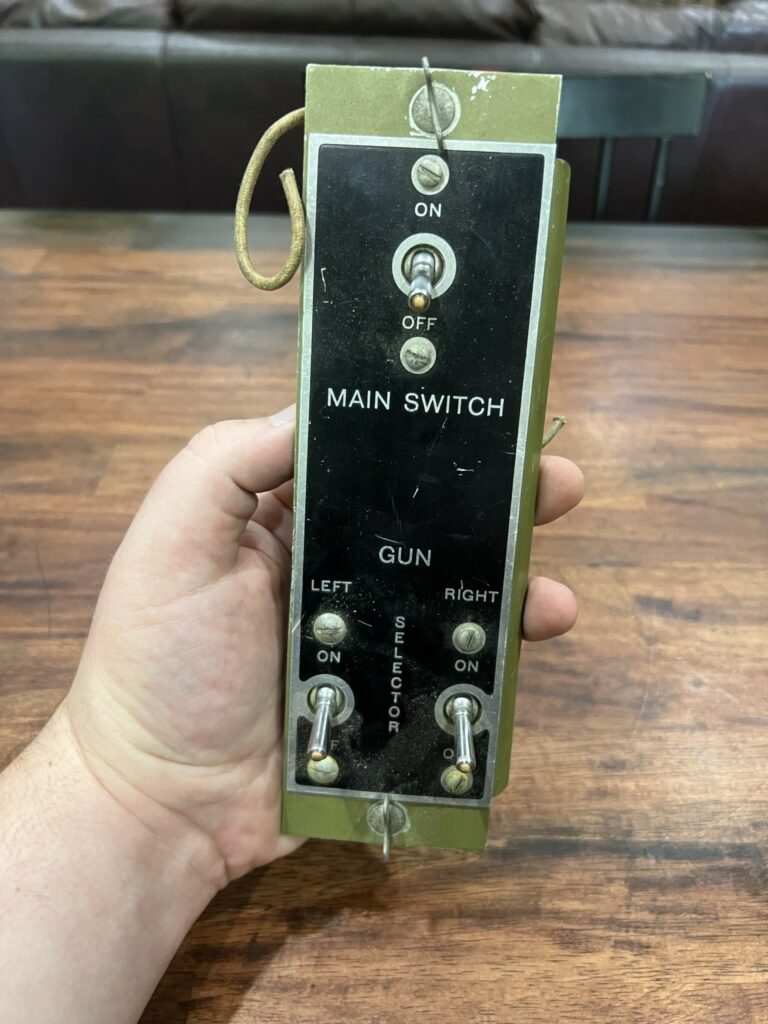
The Type A-1 Upper Turret switch panel from Hans Wuethrich.
Photo taken 17 August 2023.
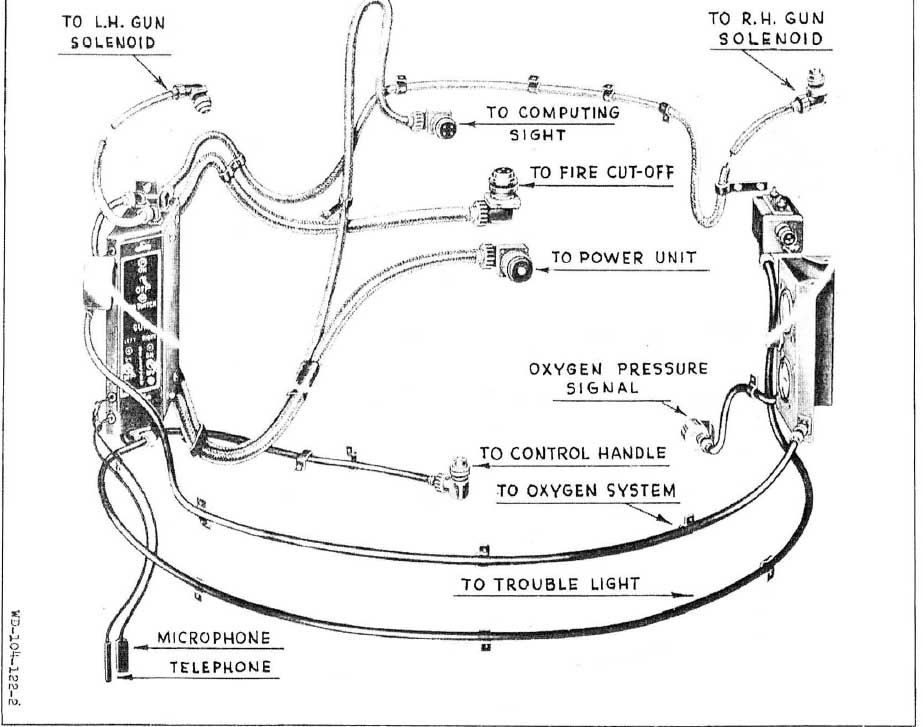
Manual illustration showing the switch panel, oxygen panel, and electrical lines to a Type A-1 Upper Turret.
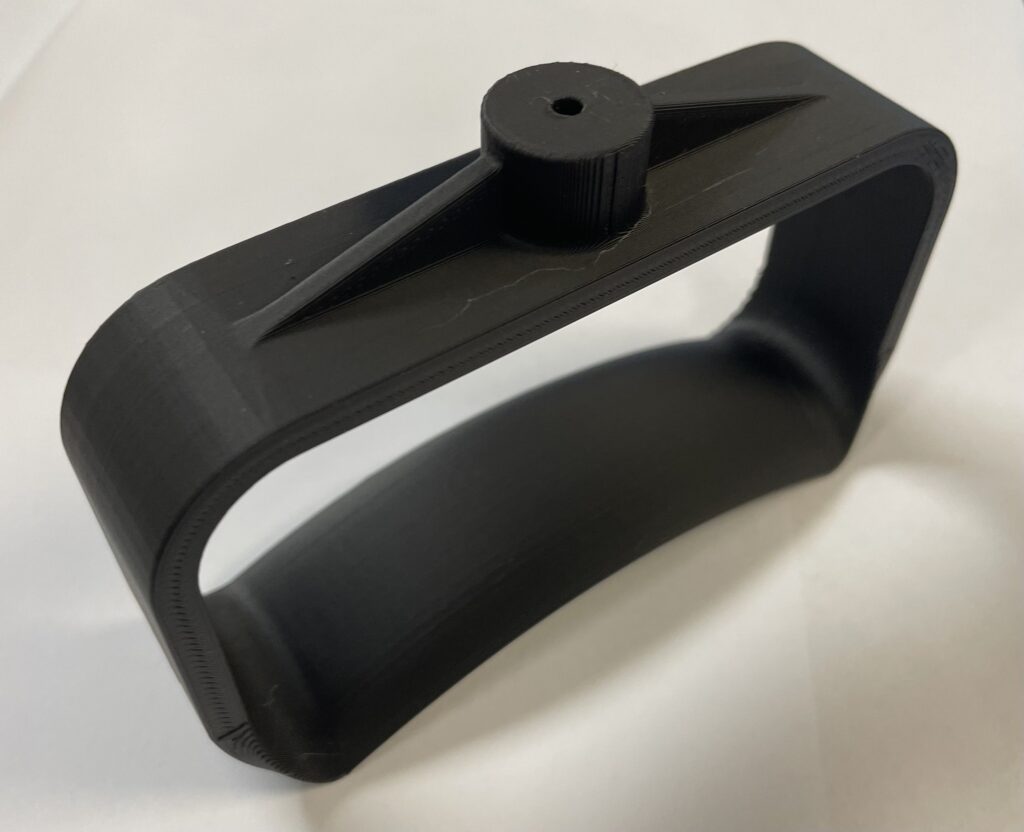
3D test print of a Type A-1 Upper Turret’s gun charging handle.
Photo taken 20 September 2023.
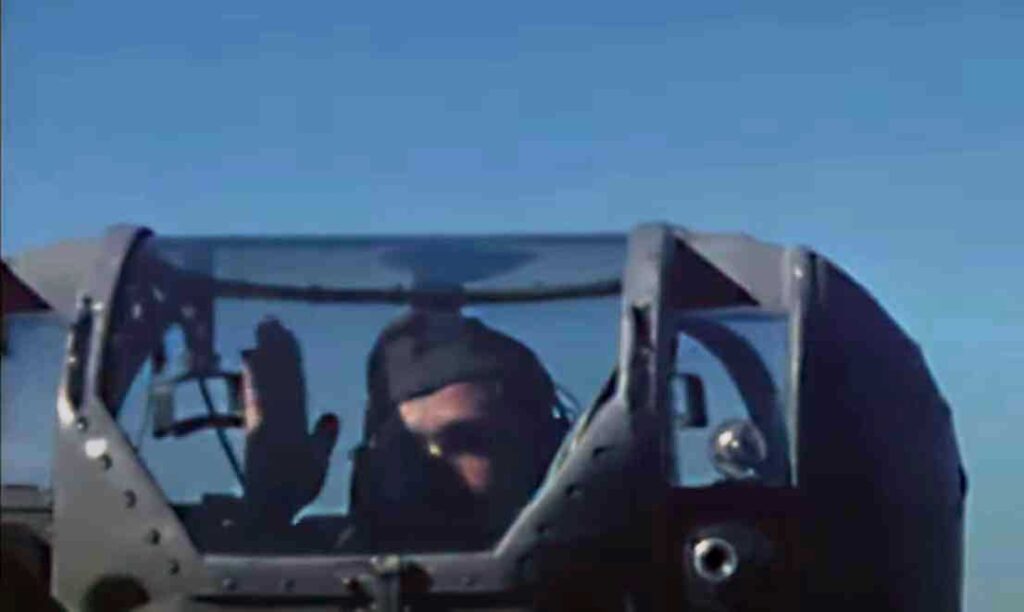
SSGT Gene Adkins poses for William Wyler’s film crew during an operation aboard Memphis Belle (41-24485, 91BG).
Note the charging handles to his Type A-1 Upper Turret.
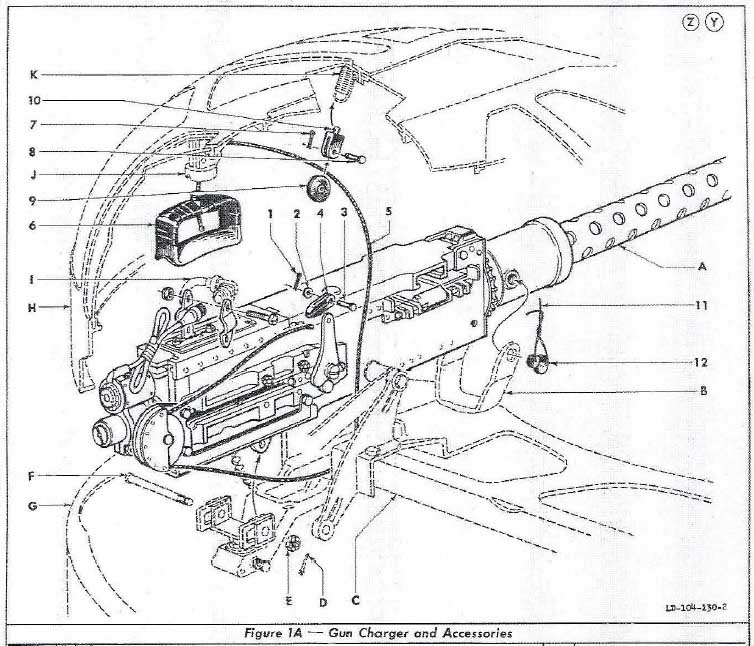
Manual photo showing the charging handles to the Type A-1 Upper Turret.
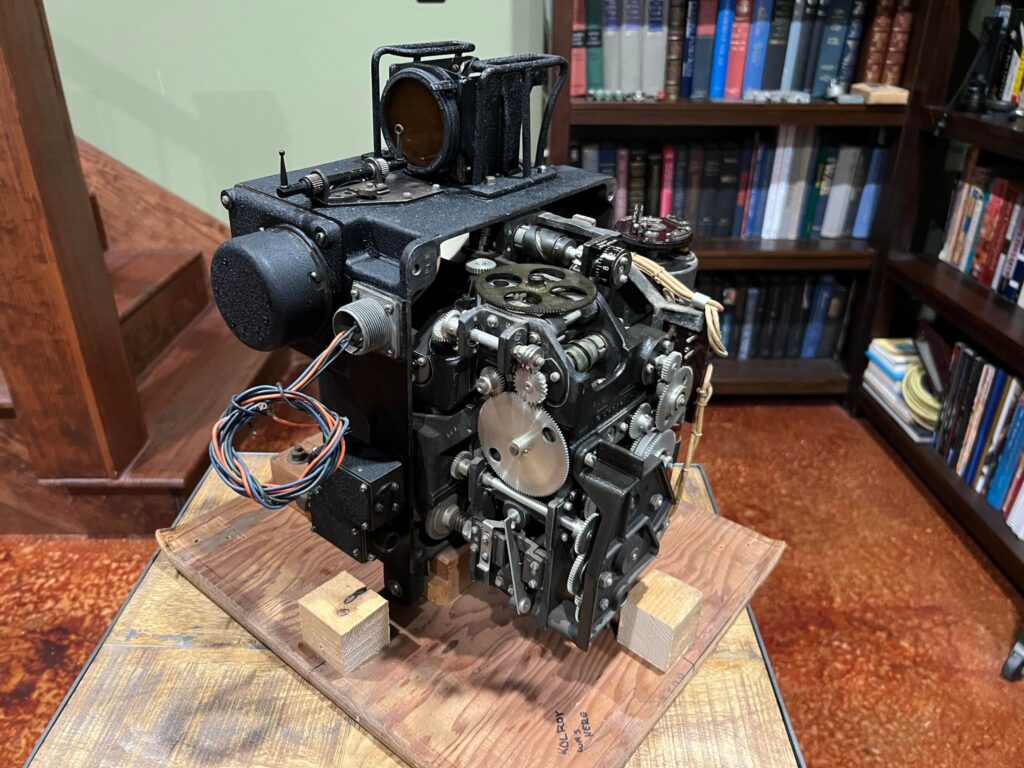
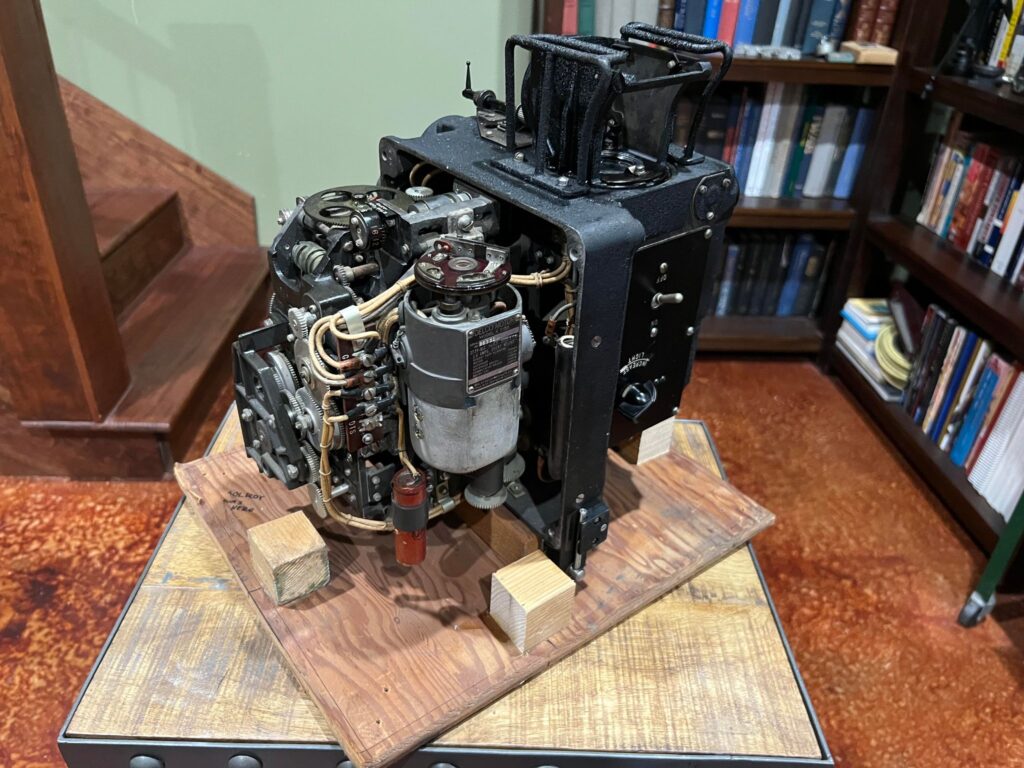
Guy Evans’s newly donated Type K-4 gunsight.
The power plug has since been replaced. If you can help replace the missing side cover and glass lens, please let us know!
Photo taken 29 August 2023.
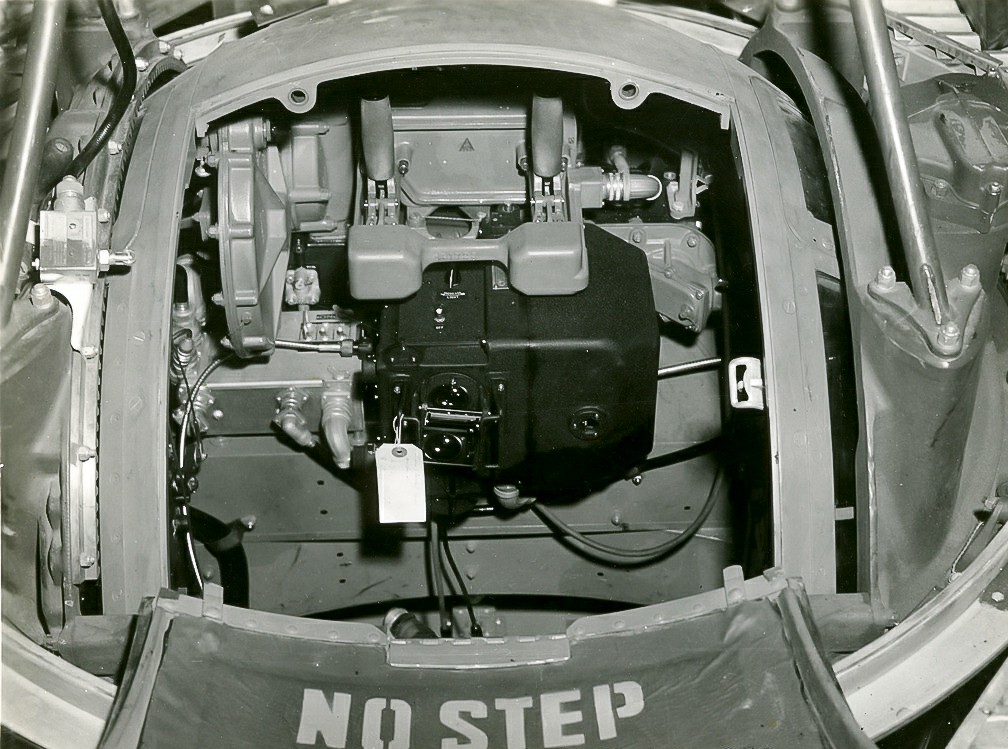
A Type K-4 gunsight is visible in this Briggs-built ball turret.
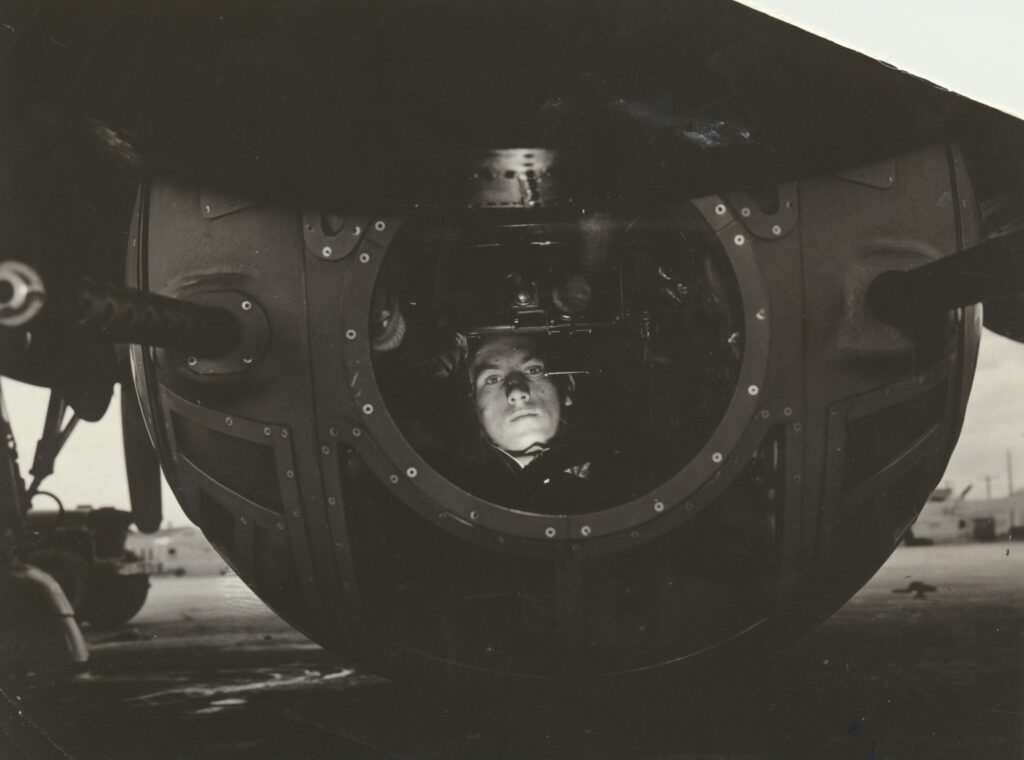
The K-4 gunsight worked as an analog computer. Drive cables from the turret fed position data on azimuth and elevation, and a foot pedal adjusted the reticule on the gunsight for range. A manual control input the target’s wingspan.
Altogether, this allowed the gunsight to lead the target so the gunner did not have to.
We wanted to finish the Command Radio shelves before Lucky Thirteen‘s 80th anniversary event at Triple Tree, and they required flanging 3.5” and 6” holes. Our friends at the Liberty Foundation generously loaned us the needed dies to flange the holes, so now the shelves are finished. Thanks guys!
The “Command Radio” was the SCR-274, consisting of two transmitters (covering 5.3 – 9.1 MC) and three receivers (covering 3 – 9.1 MC, and 190 – 550 KC). Older units were black, with silver units entering service in mid-1943. On B-17Fs like Lucky Thirteen, the modulator for the transmitters was mounted on the floor under the shelves. This was later changed in the G-series by moving the modulator to a little shelf above the radio operator’s desk. The system was controlled by the pilots via long tuning cables which reached from the radios to controllers on the ceiling above the pilots.
Speaking of work that Ray has been up to, the new skin for the area around the tail gunner’s escape hatch has been fitted. The last step before final riveting will be to apply the ALCLAD markings. These markings were visible on wartime bare aluminum, indicating thickness, composition, and manufacturer. We recreated these markings by scanning pieces of original wreckage and examples can be seen on our restored Stations 4 and 5.
In other news, we have made some major strides on the Type A-2 ball turret. Our friend Eric Miller of Project Warbird was able to locate and acquire the missing holder bar for the turret’s brush assembly!
The Type A-2 Ball Turret entered service with B-17E 42-2505 and stayed in service until B-17G 42-31554, after which it was replaced by the Type A-2A. The two are easily distinguishable from one another: the A-2 had a large, heavy frame with an external oxygen tank, the A-2A had a thin frame with a low center of gravity and a direct oxygen feed which negated the external bottle. Because of its heavy frame, the A-2 ball turret’s brush assembly (the piece from which the turret receives its electrical power) was quite large and unique.
You may remember that we were able to acquire an A-2 brush assembly back in June. This brush assembly came from a midair collision which occurred over RAF Great Ashfield on 26 September 1943 – just 20 days after Lucky Thirteen was shot down. Said assembly was missing its cover plate and brush holder, the former of which we were able to purchase in July. Now that we have the missing brush holder bar, the entire assembly can now be fully restored.
Similarly, we have also recently purchased the elevation gear for the Type A-2 ball turret on Lucky Thirteen. This piece is in superb condition! With its acquisition, we are very close to having everything necessary to restore the ball turret’s gearing assembly for live bench test demonstrations. The only needed parts left to accomplish this are the turret’s hydraulic transmission breather tank and an early style Briggs hand controller. If you can help with these needs, please let us know!
These turret purchases use up the last of the donations raised for turret parts throughout 2022 and 2023. Let it be said: 𝐰𝐞 𝐰𝐨𝐮𝐥𝐝 𝐧𝐨𝐭 𝐡𝐚𝐯𝐞 𝐛𝐞𝐞𝐧 𝐚𝐛𝐥𝐞 𝐭𝐨 𝐩𝐮𝐫𝐜𝐡𝐚𝐬𝐞 𝐭𝐡𝐢𝐬 𝐩𝐢𝐞𝐜𝐞 𝐰𝐢𝐭𝐡𝐨𝐮𝐭 𝐲𝐨𝐮𝐫 𝐝𝐨𝐧𝐚𝐭𝐢𝐨𝐧𝐬. Our sincere thanks to all of you who have contributed to Hangar Thirteen so that we may rebuild the bomber’s turrets.
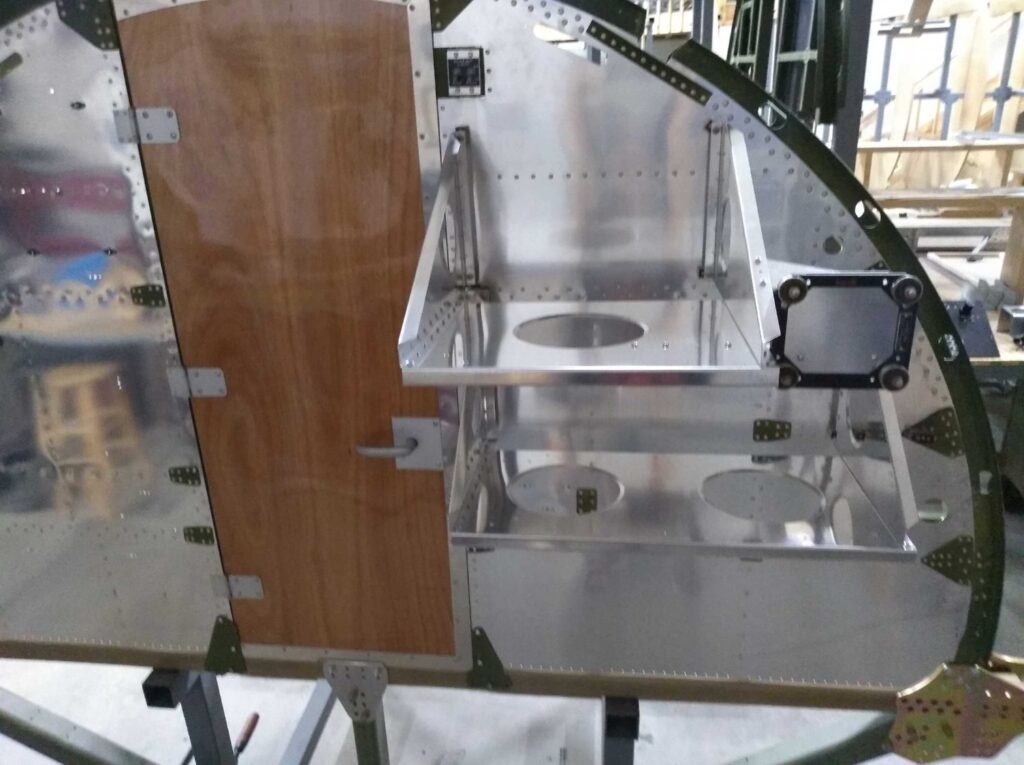

The newly completed shelves for the SCR-274 Command Radio.
The two transmitters sit on the top shelf and the three receivers on the bottom shelf. The bracket to the side holds the system’s relay, connecting it to the antenna outside.
Photo taken 1 September 2023.
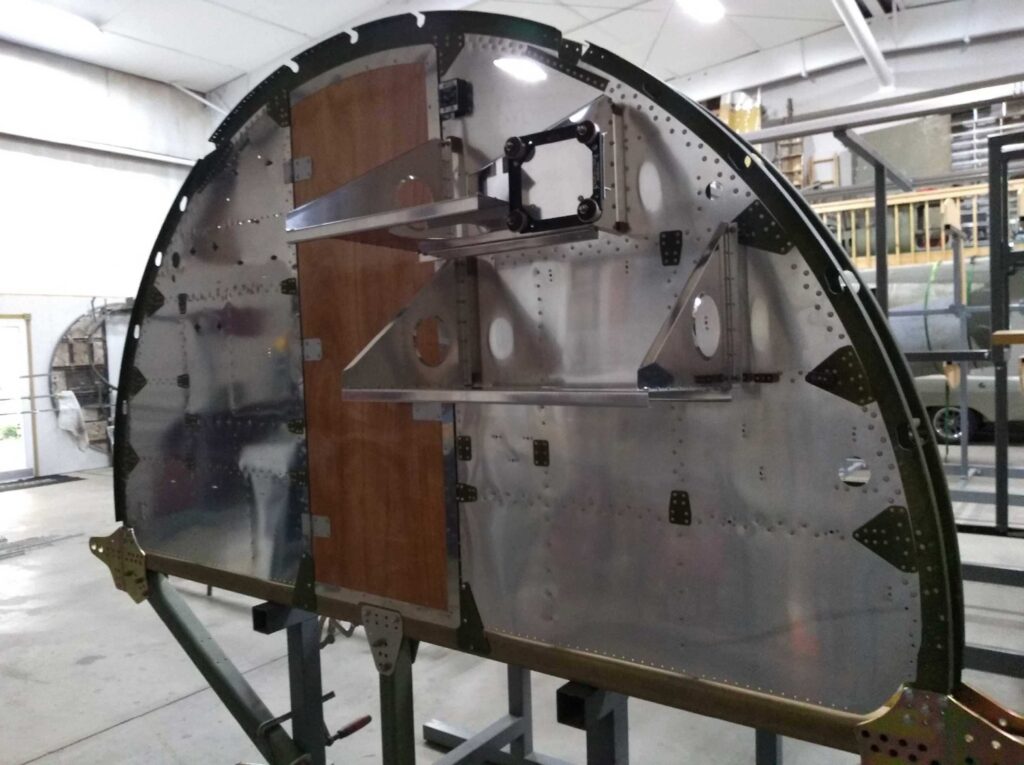
The newly completed shelves for the SCR-274 Command Radio.
Note the phenolic blocks which the shelves attach to – this is unique to E and F model B-17s. These blocks act as spacers to allow for the fabric and insulation which will later cover the bulkhead.
Photo taken 1 September 2023.

Station 5 aboard an early B-17F. The SCR-274 Command Radio is visible on the right. Note that, because this is an older F, the radios are black.
Several aspects give away that this is an older F-model. Note the linoleum covered desk. Later Fs used a painted wood desk, with non-insulated G radio compartments having natural wood desks. Another indicator is the large chart on the door, used to calculate center-of-gravity when loading equipment.
The additional seats on the right were almost always removed from combat aircraft. The radio operator’s seat on older B-17s was a bucket-style seat, similar to the one used by the pilots. Later Fs and early-Gs used Cramer posture chairs, before returning to the bucket seat in the late-Gs.

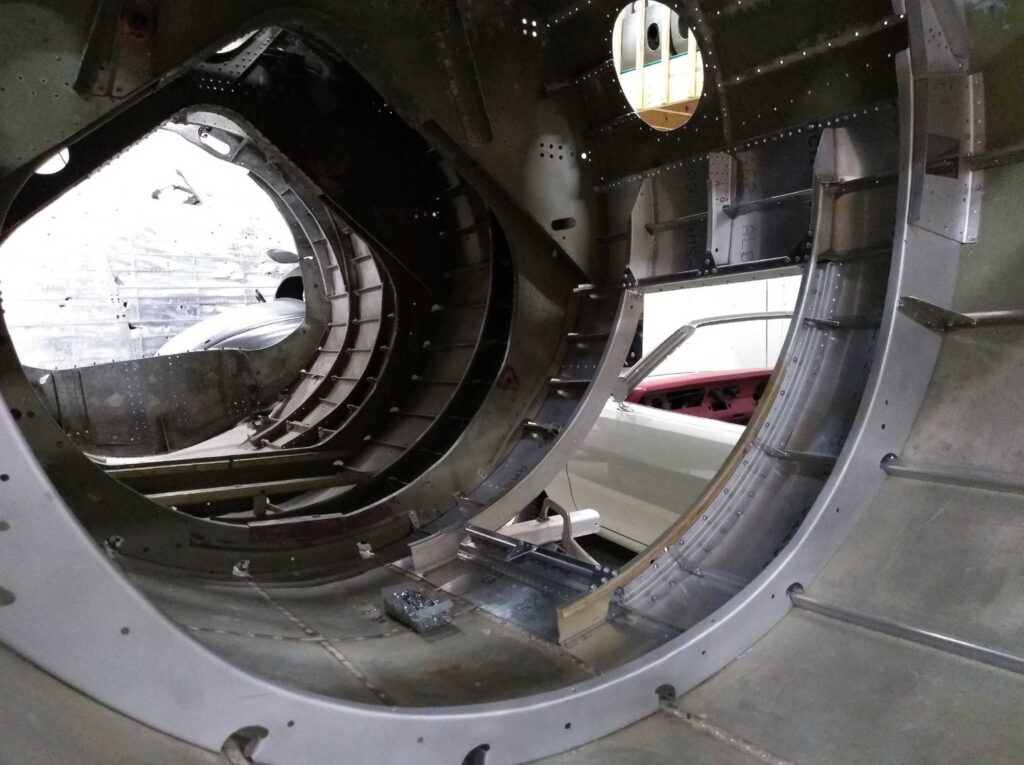
The new skin fitted into plate around the tail gunner’s escape hatch on Lucky Thirteen.
Photo taken 5 September 2023.
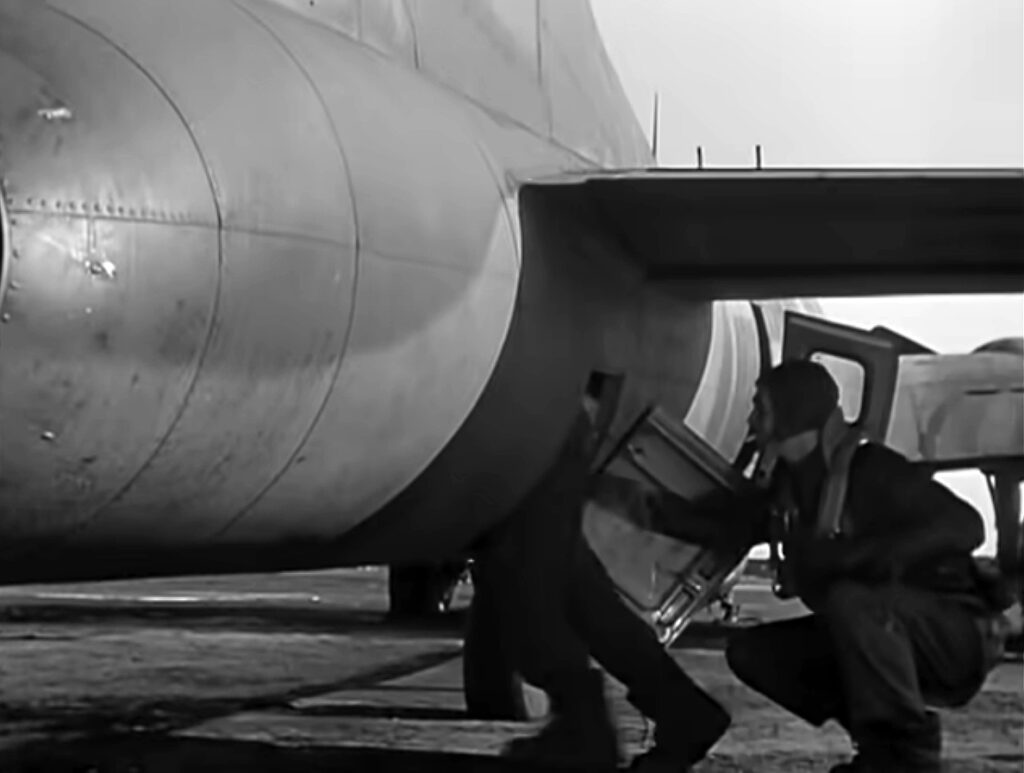
A screenshot from Target for Today shows an airman enter his Boeing B-17 from the tail gunner’s escape hatch.
Target for Today was an attempt by the Army to break down the operations of a typical US 8AF strike. The film follows the planning and execution of the 9 October 1943 bombing of Anklam, Malbork, and Gdansk, Germany and Gdynia, Poland. By that time, Lucky Thirteen had already been lost.
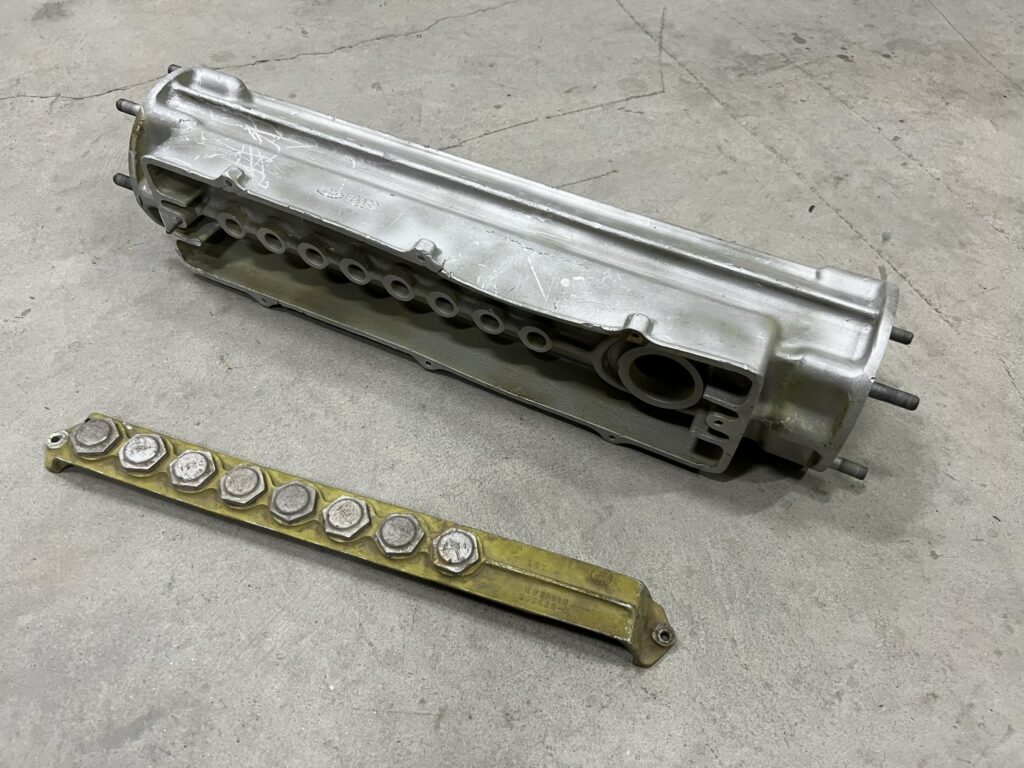

Test fitting the newly acquired brush holder bar in the Type A-2 Ball Turret’s brush assembly.
While the turret was designed by Sperry Gyroscope, manufacturing was handled by Briggs of Detroit, Michigan and Emerson Electric of St. Louis, Missouri. While the holder bar is an Emerson, it fits the Briggs assembly casing perfectly.
Photo taken 22 August 2023.
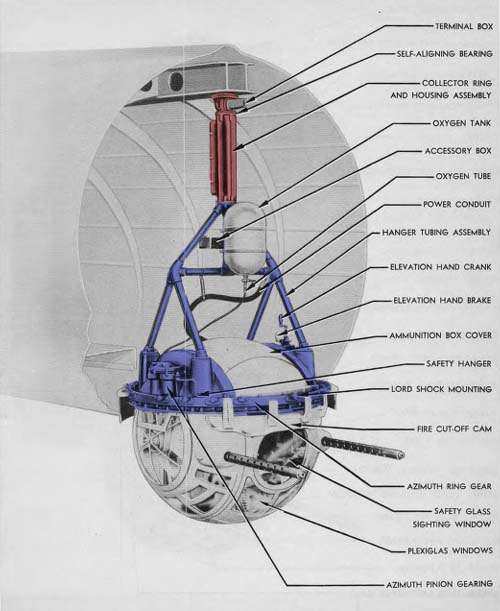
A manual illustration of a Type A-2 Ball Turret.
The brush assembly has been highlighted in red.
The hanger and trunnion assembly has been highlighted in blue. A trunnion/hanger has been offered to us for the price of 25,000 USD, if we can raise the money.
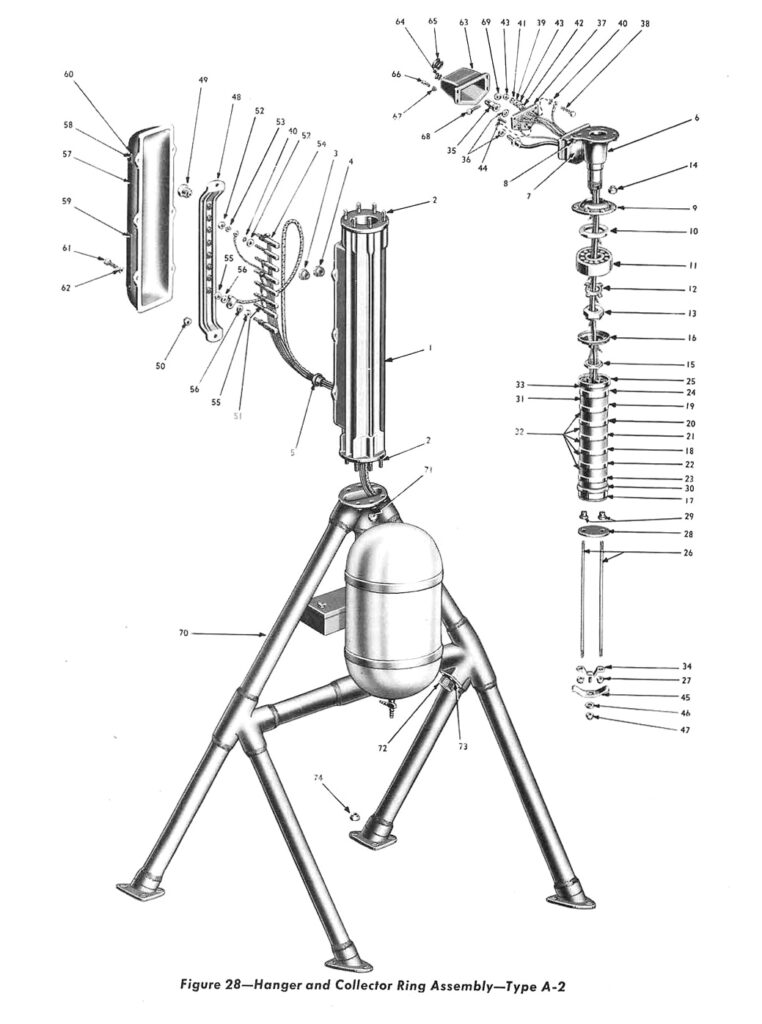
Manual illustration of the brush and hanger assembly. The retainer mounting plate is missing from our brush assembly.
The secret to the turret’s power is the collector ring assembly: the long tube piece on the far right.
Power from the airplane goes to this piece, which is then picked up by wires which “brush” against the rings. This gives the turret power while allowing it to move unencumbered.

The newly acquired ball turret elevation gear.
The red handle is a crank for manually traversing the turret up and down.
Photo taken 21 August 2023.

Manual illustration of the Sperry ball turret’s motor assembly.
An electric motor is sandwiched between two hydraulic transmissions. Each transmission is connected to a gear assembly – the elevation gear on the left and the azimuth gear on the right.
We now have everything in this illustration except for the hydraulic breather tank.
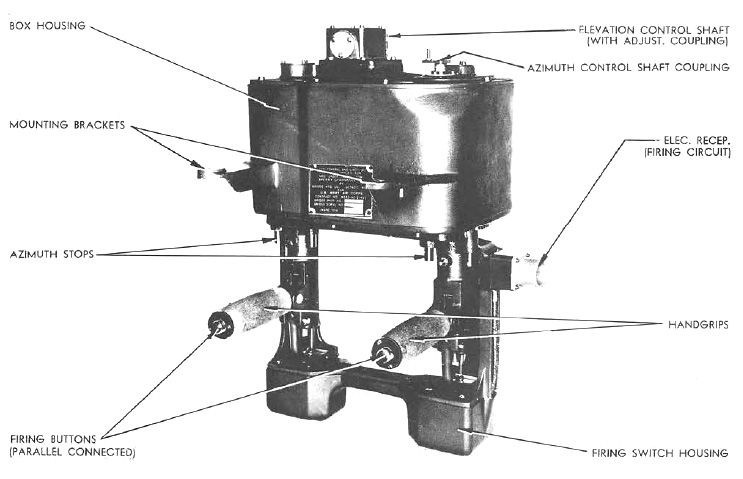
Manual illustration of a Type A-2 Ball Turret hand control assembly.
Type A-2A ball turrets lacked the large housings below the handles.
We are in need of one of these, preferably a Briggs model (gray colored instead of green). If you can help with this – either through parts of financial donations – please let us know!
The hand control and hydraulic breather tank are the only pieces we lack to begin restoration of the ball turret’s motor assembly.
With the aft fuselage of Liberty Belle finished and delivered to the the Liberty Foundation in Douglas, Georgia, Ray has started rebuilding the aft fuselage of the Lake Dyke B-17. Since this bomber requires starting at Station 11 (the rear-most aft fuselage bulkhead), Ray has taken the opportunity to work on the aft fuselage of our own Lucky Thirteen at the same time. We do not have enough hangar space to set up three B-17 fuselage jigs, but we do have a fairly large hunk of aft fuselage. So, as each piece is restored, it is placed back into its original position.
Recently, Ray has completed the bracing which holds the tail gunner’s escape hatch, some of which is original and some of which required rebuilding. This beautiful piece of metalwork formed and in place, it was a treat to stick the actual hatch in place on the tail of Lucky Thirteen. Kudos Ray!
The day Gili Kieffer of Warbird Pinups visited the hangar – whose work you should definitely follow – also saw a visit from our friend Chris Erdahl of Asheville Product Development Solutions. Chris has been helping us with the broken piece of our top turret dome.
To recap:
The top turret dome for Lucky Thirteen is a Type 2 dome purchased in 2021 thanks to the monumental efforts of Keith Ellefson, Karl Hauffe, Ray Moore, Don Price, Andy Rivera, and Chris Wilkinson. Type 1 and Type 2 domes were externally identical, being only differentiated by the company which produced them: Steel Products & Engineering (SPECO) for the first, and Emerson Electric for the latter. While SPECO went through multiple dome designs, Emerson only changed dome designs once, using the Type 2 for most of its run. This is how we know that Lucky Thirteen had an Emerson-built upper turret – and this dome, being an Emerson, is correct for us.
At some point in its history, the dome was dropped and the fairing under the left gun broken away. We had hoped that a 3D scan of another Type 2 dome fairing would allow us to design a plug which we could weld into place. However, we discovered that the fairing was redesigned partway through production, as the two did not match. (Evidently, our dome came from early in Emerson’s Type 2 dome production.) This is where Chris stepped in. Chris scanned the right gun fairing and has been using it as a guide to design a plug for the missing left fairing. Since the dome is not a perfect circle, this has taken some time.
Chris came to the hangar with three 3D prints to test his work on the missing fairing. Since one of them was a perfect match, it only now remains to have this missing piece cast and welded into place. Once this is done, we can begin restoration of the top turret dome in its entirety!
In other news, our friends at Planes of Fame Air Museum sent us a pair of Pioneer Type A-12 oxygen regulators. This brings us just five regulators away from a full complement for Boeing B-17F Lucky Thirteen!
The Type A-12 regulator was the most common demand-flow oxygen regulator used by the US Army Air Forces in the Second World War. Two major variants existed of this regulator: the Aro type and the Bendix type. The Aro regulator type had flat sides and a distinctive flower shaped filter on its face; the Pioneer regulator type had rounded sides and a single hole in the center for the diaphragm. Both were also made under license. Either type would be correct for Lucky Thirteen, though we have elected to pursue outfitting the bomber with a full set of Pioneer type regulators.
These two regulators came to us complete with a few of their original brass fittings still attached. This was exciting for us as brass fittings are accurate to our 1943 aircraft. A technical order dated 5 January 1945 discontinued brass oxygen fittings in favor of aluminum ones. Aluminum oxygen fittings can be easily spotted on surviving aircraft by their blue anodized finishes. As such, it is our intention to outfit Lucky Thirteen with all-brass fittings for her oxygen system.
If you can help with the oxygen needs for Lucky Thirteen, please let us know! Brass oxygen fittings, Pioneer type A-12 oxygen regulators, and Pioneer regulator hose fittings are especially welcome. (Frustratingly, an Aro type hose fitting will not screw onto a Pioneer regulator…)
Special thanks to our friends at Planes of Fame for these regulators! If you have not followed their work on Boeing B-17G Piccadilly Lilly II, we highly encourage you to do so – they are some of the most awesome people.
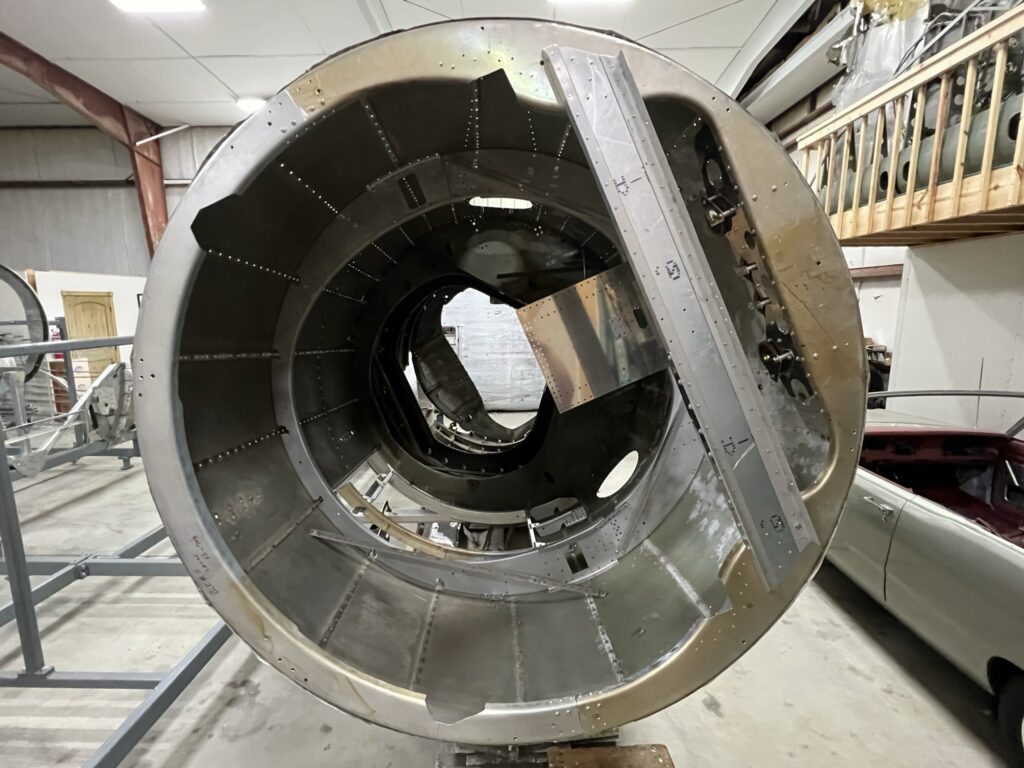
Looking up the aft fuselage of Lucky Thirteen. The newly rebuilt Stations 11 and 10 are visible, as is the framing for tail gunner’s escape hatch. All are mixtures of new and original components.
Photo taken 22 August 2023.
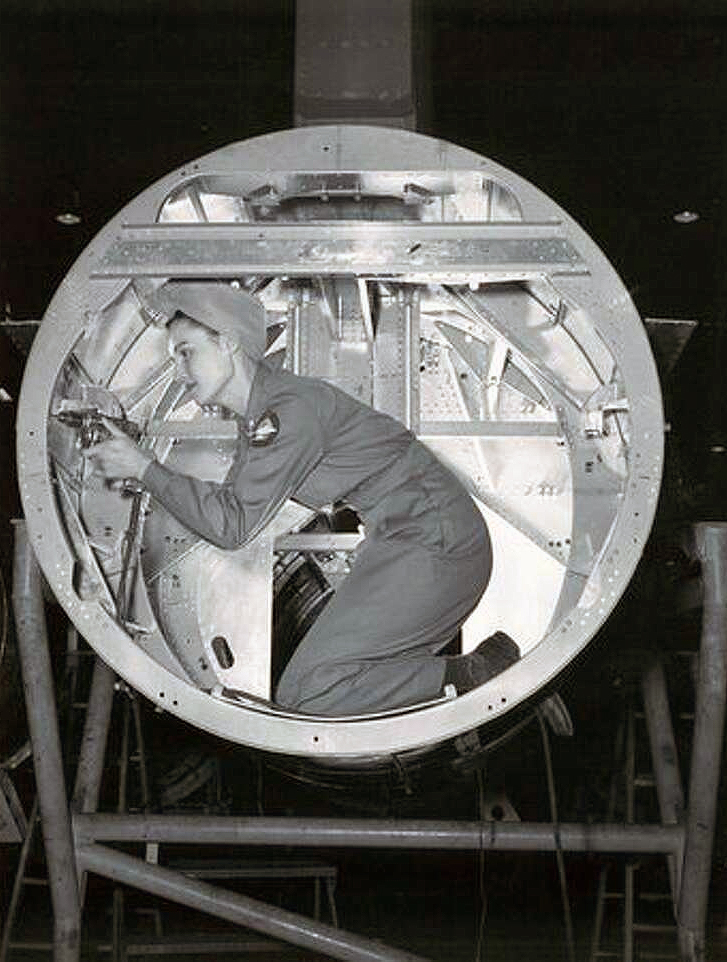
A riveter at work in the same position in wartime.
This photo was taken at Boeing’s Seattle plant.
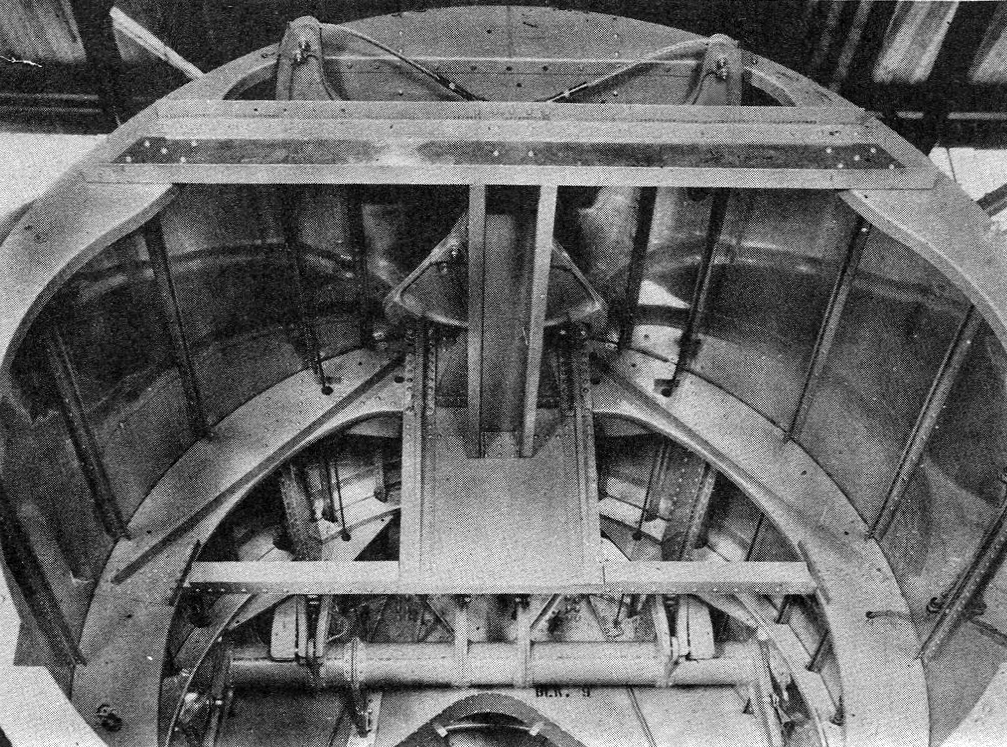
Manual photo showing the tail section of a Boeing B-17 in detail.
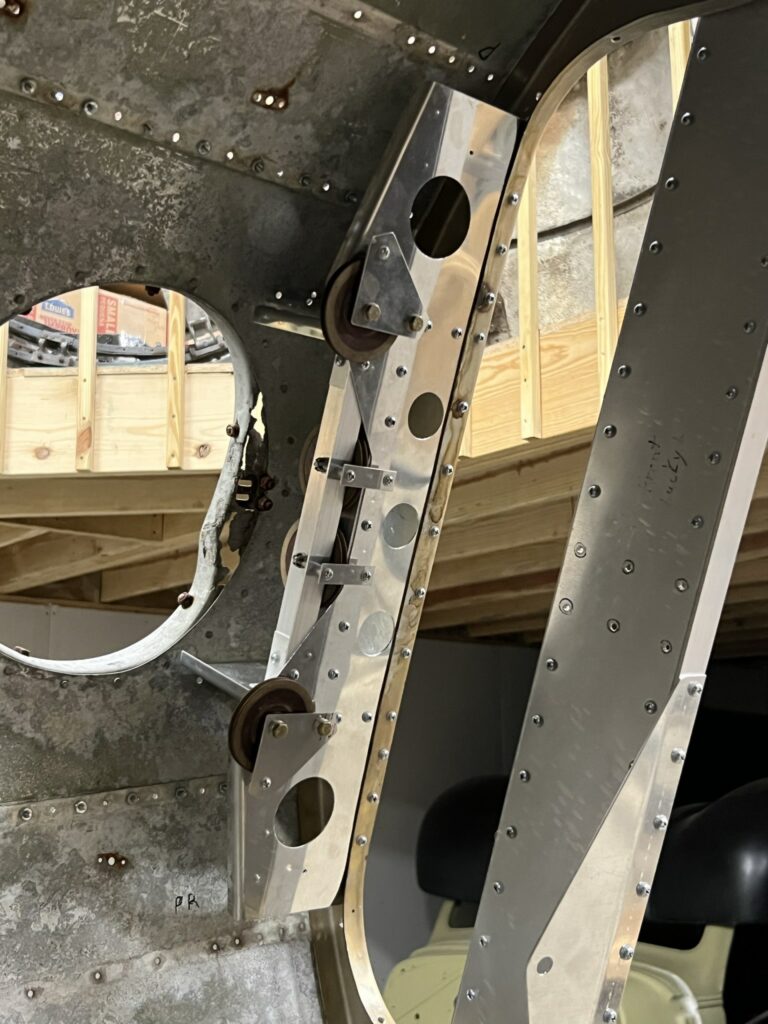
One of the complex pulley assemblies for the tail control surfaces, restored and mounted just behind Station 11 on Lucky Thirteen.
Photo taken 22 August 2023.
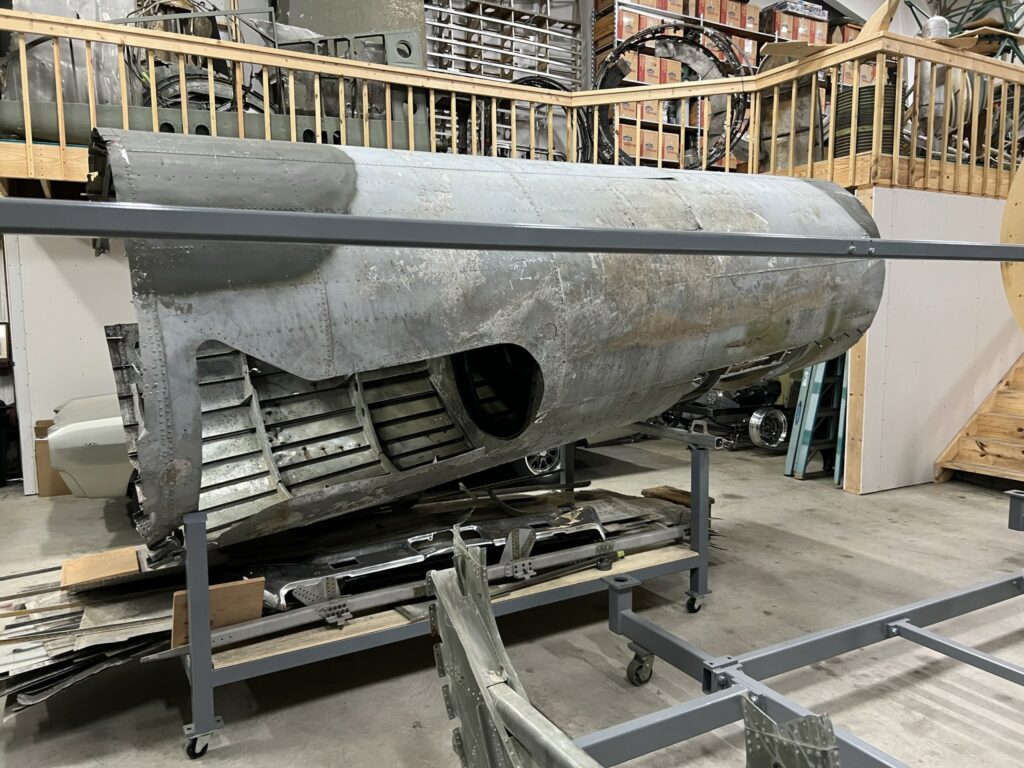
The aft fuselage of Lucky Thirteen is tilted to allow ease of work on the tail gunner’s escape hatch.
The large opening you see was for the tail wheel.
Photo taken 22 August 2023.
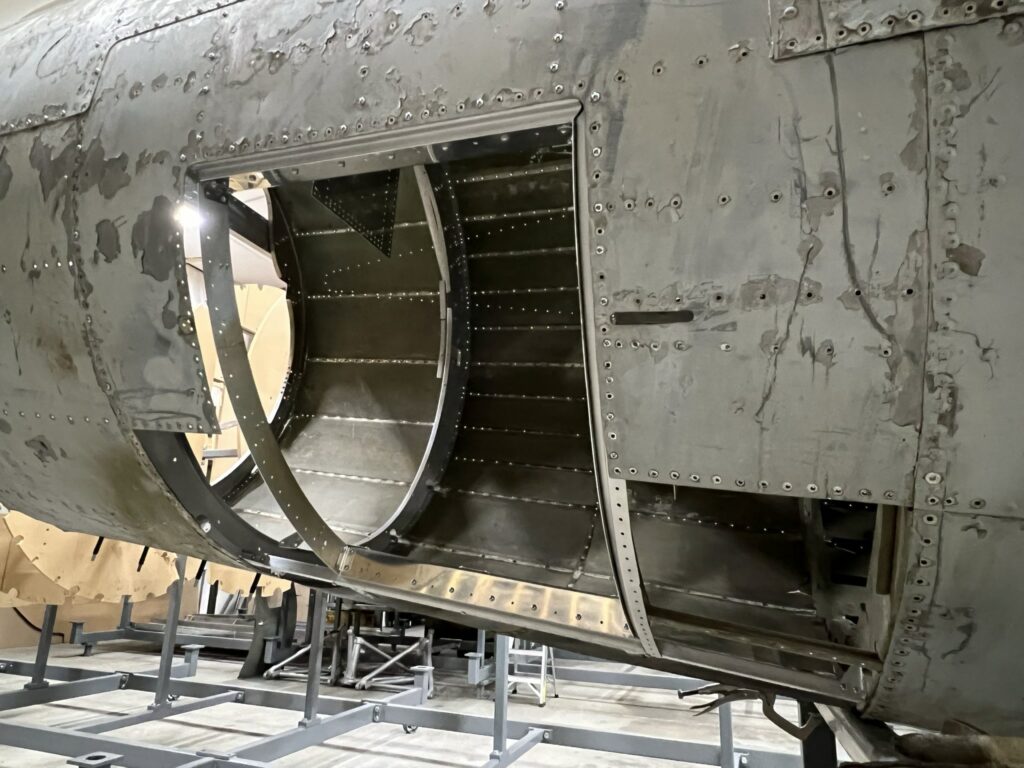
The framing for the tail gunner’s escape hatch is fitted into place.
Photo taken 22 August 2023.
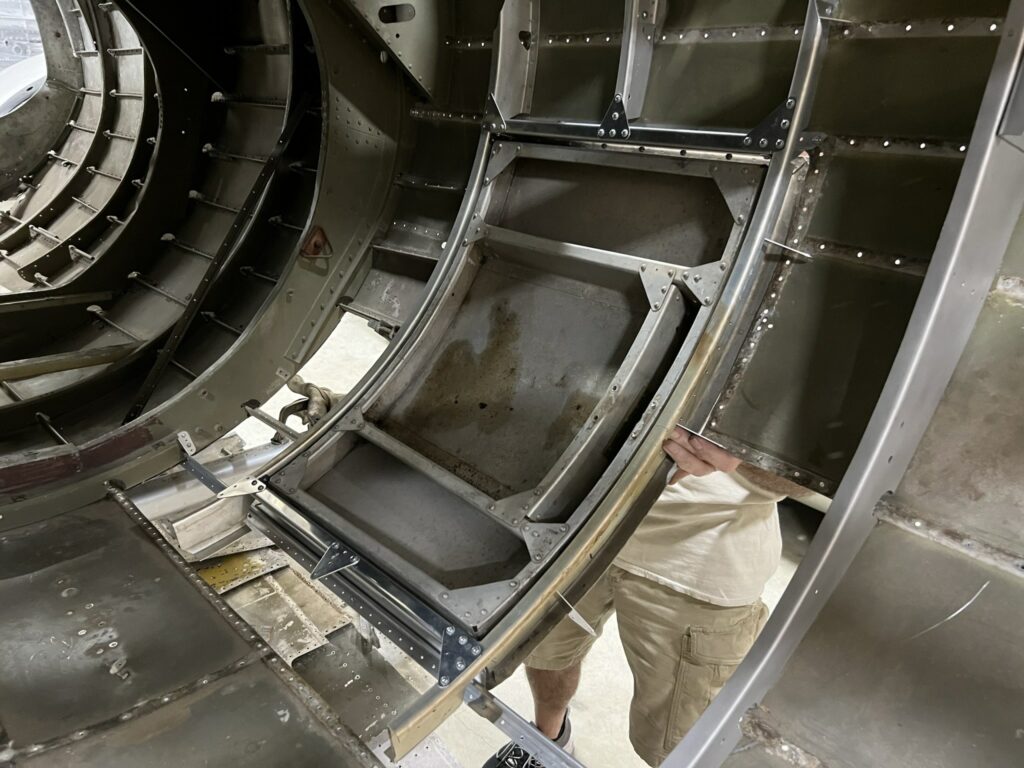

The tail gunner’s escape hatch is held in place against the aft fuselage of Lucky Thirteen.
There is a factory break point near Station 9 that will allow us to soon start redoing the skins in this area. It will look drastically different once we reach that point.
Photo taken 22 August 2023.

A screenshot from Target for Today shows an airman enter his Boeing B-17 from the tail gunner’s escape hatch.
Target for Today was an attempt by the Army to break down the operations of a typical US 8AF strike. The film follows the planning and execution of the 9 October 1943 bombing of Anklam, Malbork, and Gdansk, Germany and Gdynia, Poland. By that time, Lucky Thirteen had already been lost.
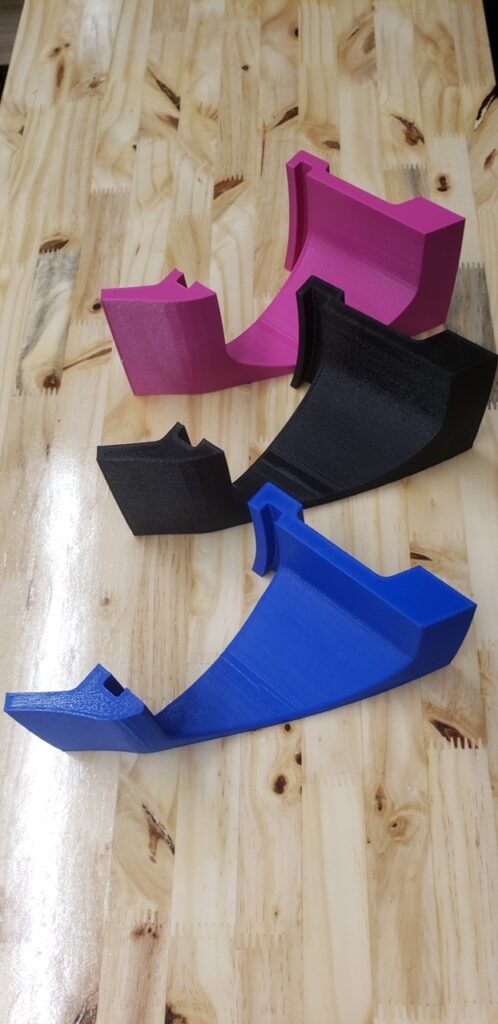
3D test prints of the top turret dome’s right gun fairing.
Each have been adjusted in an attempt to account for the dome’s imperfect circle. In the end, the pink print was a match.
Photo taken 17 August 2023.

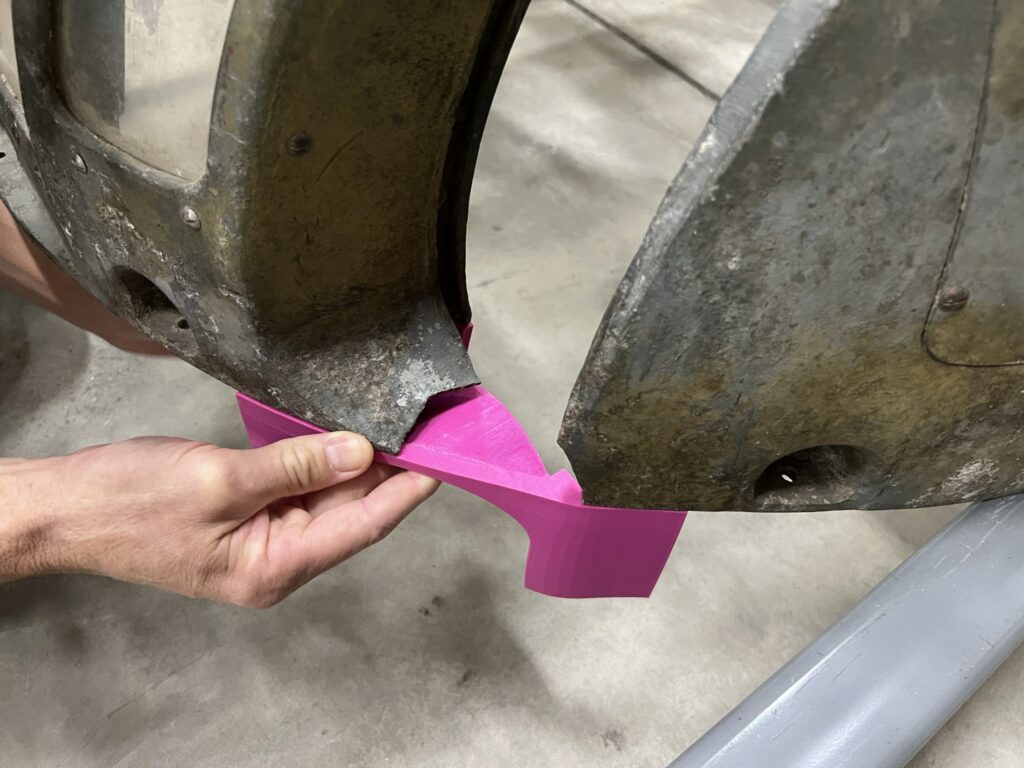
The 3D test prints are held in place upside down against the left fairing to see which one matches the curvature. The pink one matched.
The model has now been reversed and is ready for casting. Once someone casts a new fairing, we can weld it to the dome, making it hole again.
Afterward, we can begin restoring he top turret dome in depth.
Photo taken 22 August 2023.
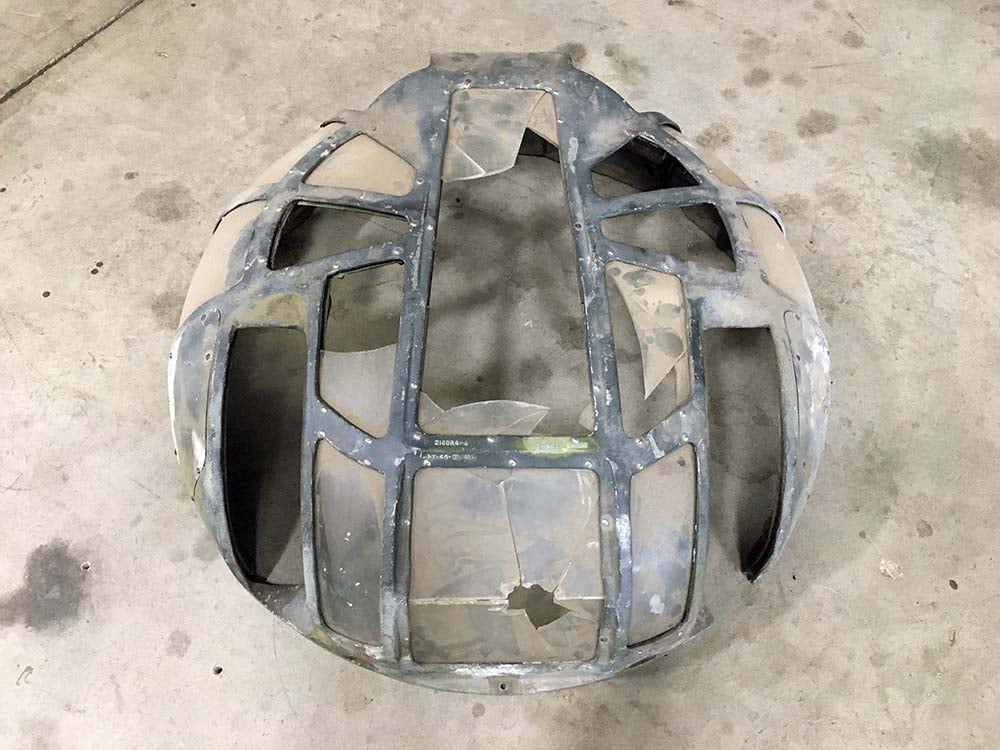
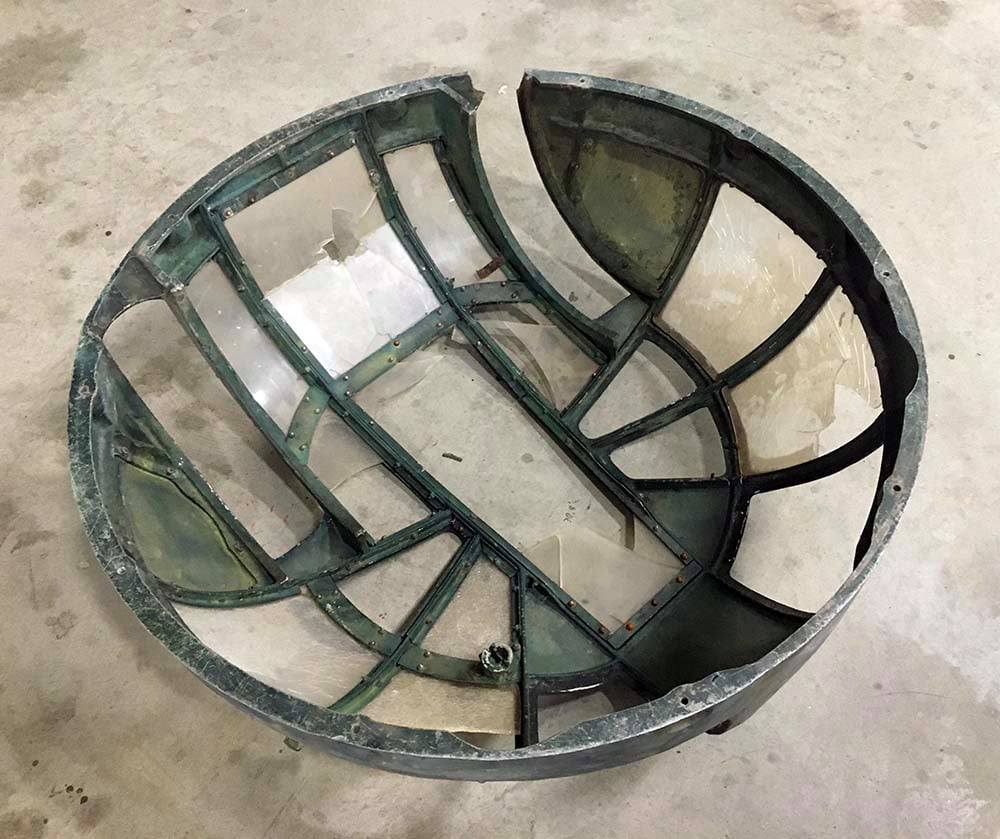
The top turret dome for Lucky Thirteen.
The plexiglass is .25″ acrylic.
Photo taken 30 September 2021.
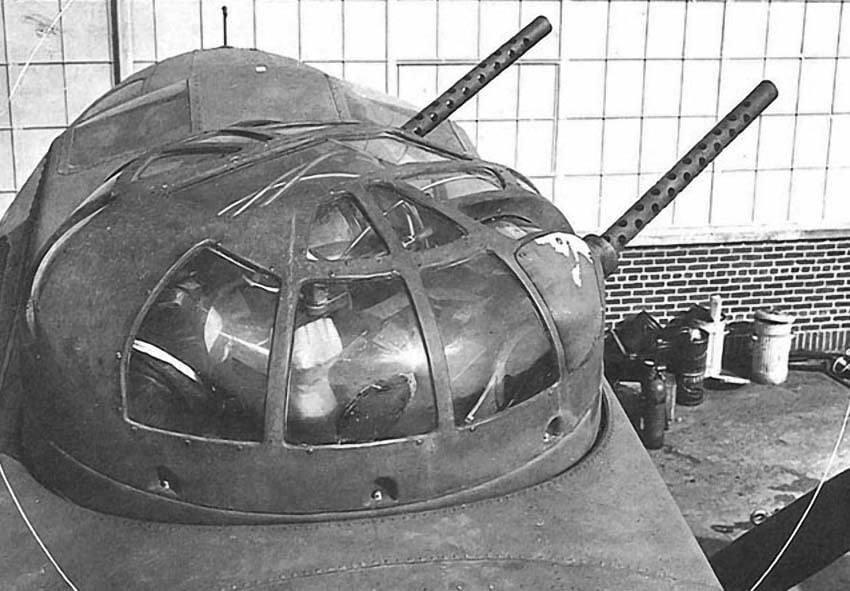
A Type A-1 Upper Turret in service.
While the Type 1 and Type 2 domes were virtually indistinguishable, later domes were more varied. They were taller and usually featured bolted components for ease of access.
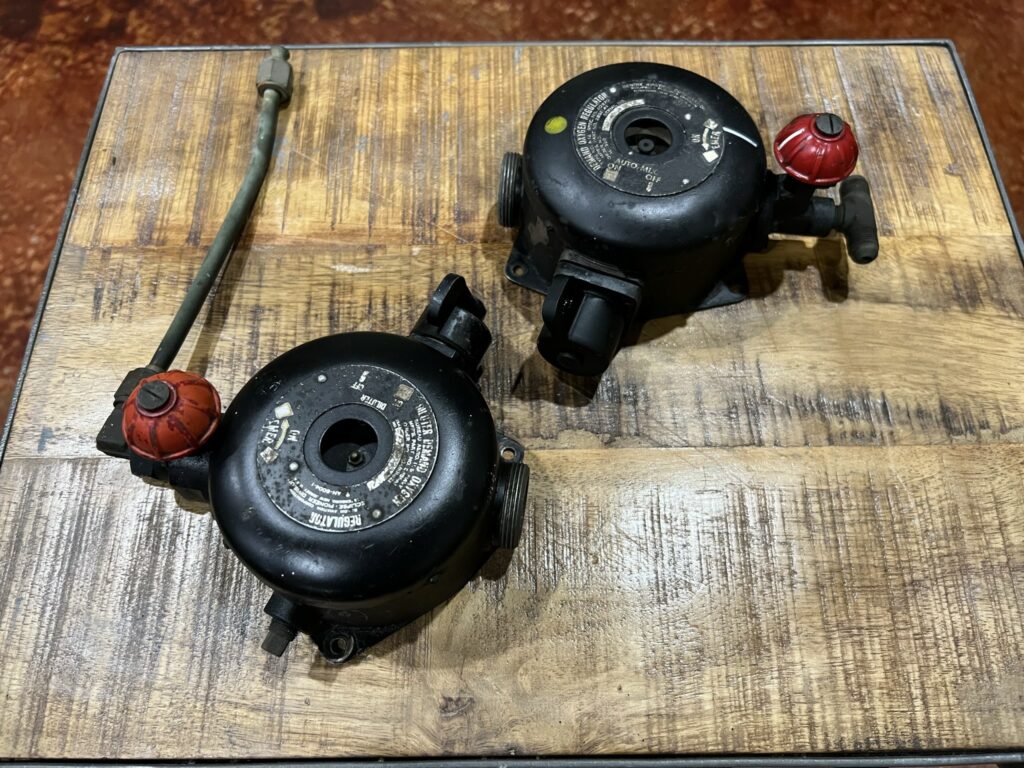
The newly arrived Pioneer Type A-12 Oxygen Regulators from Planes of Fame in Chino, California. They had just been cleaned when this photo was taken.
Photo taken 20 August 2023.
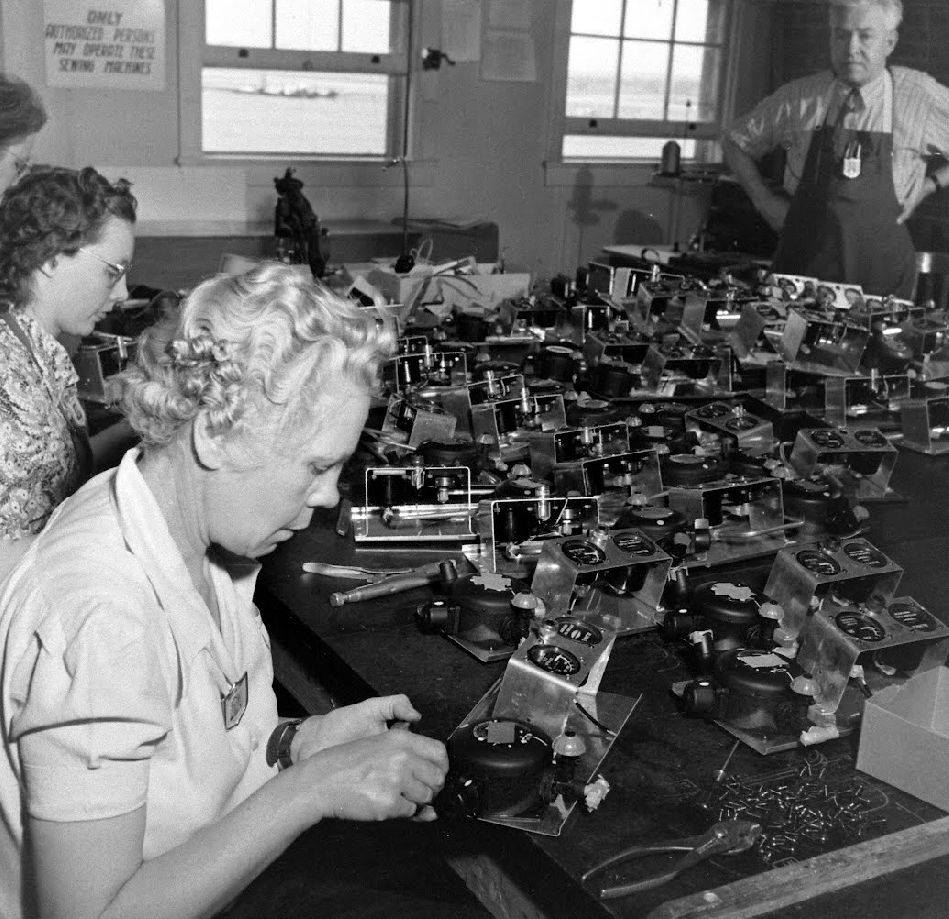
Employees at the United Airlines Modification Center in Cheyenne, Wyoming assemble oxygen panels for Boeing B-17s.
Note that the panels shown here all have Pioneer type regulators installed.
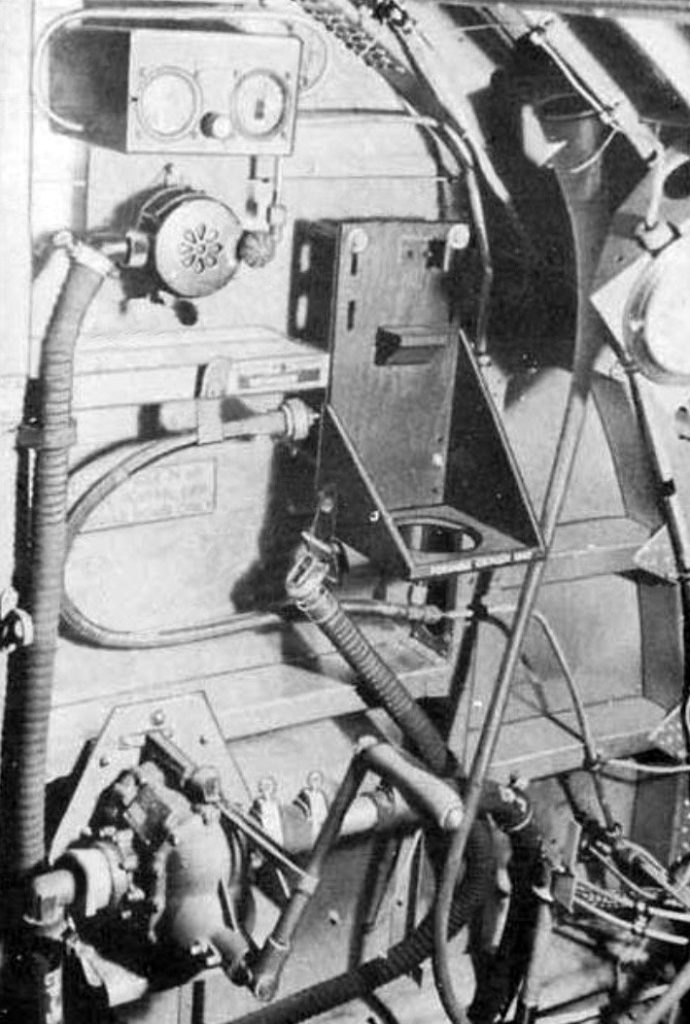
A manual illustration of the Station 5 oxygen equipment aboard a B-17F.
The oxygen panel here is equipped with an Aro Type A-12 Regulator, while we have elected to use types made by Bendix Pioneer. Both were common in wartime. We need at least five more to completely outfit the bomber.
Curiously, the fittings which attach the hose to the regulator are sized differently between brands, and only one of our regulators still has its hose attachment fitting. If you can help with this, please let us know!
To the right, on the wall, are one of the overhead lights for the bay, as well as the urine “relief” tube.
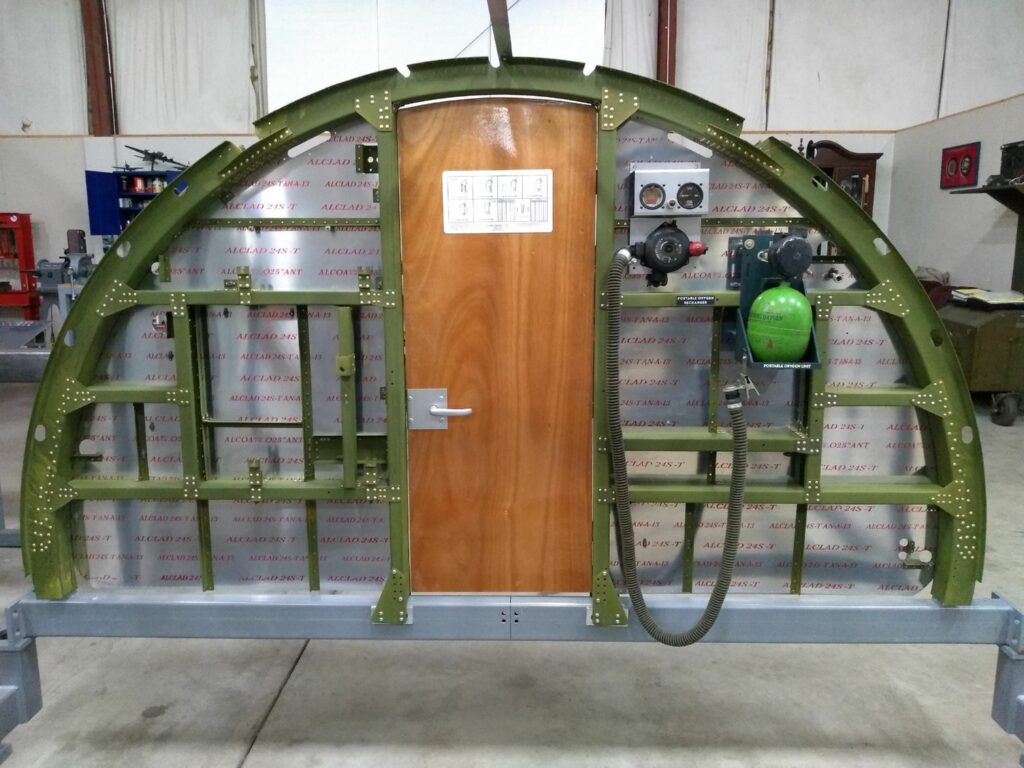
The bomb bay side of Sta. 5 for Lucky Thirteen.
Since Lucky Thirteen was a Douglas-built B-17, we have followed Douglas practice of dipping ribs and stringers in zinc chromate. We have painstakingly recreated the ALCLAD stamps on the bare aluminum skins. Contrary to popular belief, B-17s did not have painted interiors.
Photo taken 11 January 2023.
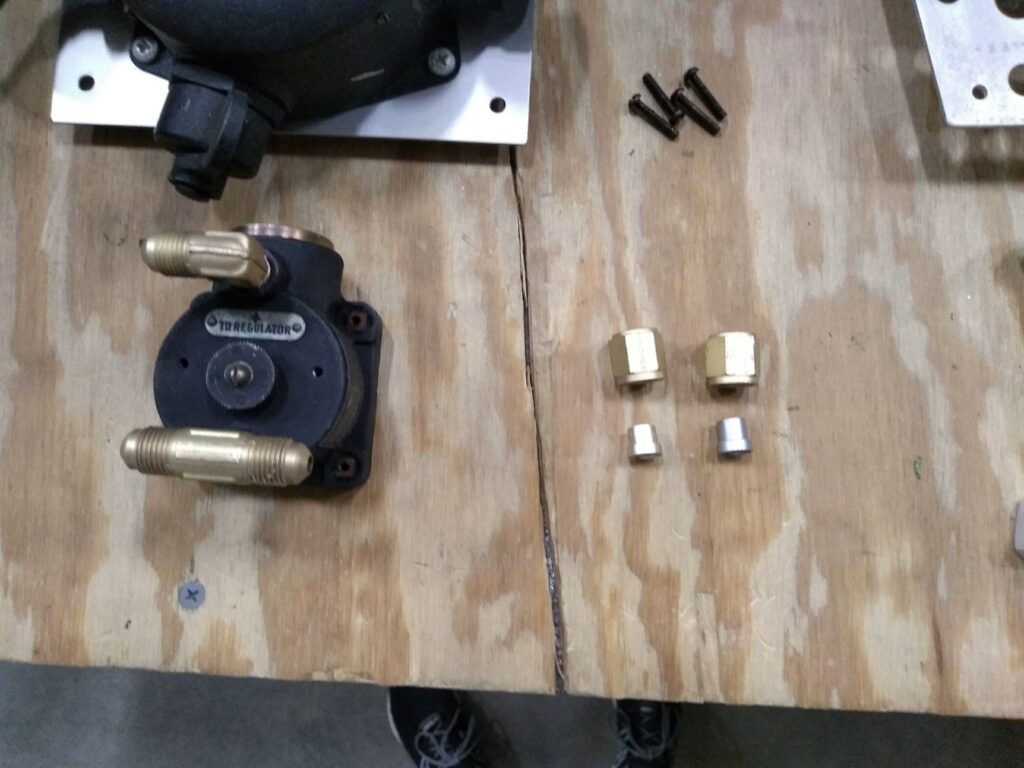
The brass fittings from the Planes of Fame regulators are cleaned and fitted to components of the bomb bay oxygen panel.
Brass oxygen fittings are accurate to our aircraft, as anodized aluminum fittings did not enter service until late in the war. If you have any brass oxygen fittings and would like to help out, please let us know!
Photo taken 23 August 2023.
Another instrument panel piece has been completed for Boeing B-17F Lucky Thirteen – the primary controls for the bombardier’ instrument panel.
The bombardier’s instrument panel was located to the airman’s left. Said panel was broken into sections, with instruments which repeated needed information from the cockpit, and controls for bomb rack selection, indicator lights for the bomber formation, and bomb release interval timing. The recently completed controls took up the upper right of the bombardier’s instrument panel.
This portion of the bombardier’s panel changed considerably throughout the B-17’s lifespan. As such, our panel is rather unique amongst surviving B-17s. Special thanks are due to Joe McKowen for donating various switches and lights, Asheville Metal Finishing for their beautiful black finish, and Avery Schroeder of DryTransfer.com for reapplying the original phosphorescent markings. We must also thank Don Keller of B-17AirDepot.com, who tracked down the lights for the rack selectors. These lights were unique to older B-17s, and for a period we feared that they were no longer in existence. Thanks to all who made this possible!
We also would like to give a special thanks to our friend Bob Dicey, who came by to visit the hangar last Thursday. Bob had already donated a Type F-1 Oxygen Tank for the Type A-2 Ball Turret on Lucky Thirteen, but decided to bring by an AN-104-A VHF Radio Antenna and the bomber’s astrodome! The astrodome is particularly exciting for us. While there are a fair number of surplus astrodomes out there, almost all are late/postwar variants with premade metal edging and a higher dome radius. Bob’s donation is period accurate to our Boeing B-17F.
The astrodome was a plexiglass dome mounted above the navigator’s position for use with the aircraft sextant and astrocompass. In theory, the navigator could triangulate the aircraft’s position by taking a reading off a known star (say, the sun). In practice this technique was rarely effective, as even competent readings were only accurate to within five miles. Astrodomes were introduced in B-17F blocks 75-BO, 15-DL, and 15-VE, though it was not uncommon for units to remove the domes overseas to improve pilot visibility.
The VHF radio was a piece of equipment originally developed by the British and adopted by the US as the SCR-522. A short-range, line-of-sight antenna, aircraft with VHF systems were easily identifiable by their large mast antennas. In the case of the B-17, said antenna was mounted above the waist compartment. The system was surprisingly compact, the transmitter and receiver being mounted in a large case, with a box-like dynamotor providing power. The radio was controlled by a selector switch mounted in the cockpit.
For most of the war, the SCR-522 was installed at modification centers, like the United Airlines facility in Cheyenne, Wyoming. Here the radios were installed on plywood shelves just opposite the ball turret. It was not until late in the B-17G series (G-80-BO to be exact) that the VHF systems were factory installed, being placed in the camera pit under the radio compartment floor.
Lastly, some of you might recall that our research recently revealed that B-17F radio operator tables, after wooden variants replaced the linoleum types, were painted on older aircraft with insulated radio compartments. As such, we needed to paint our radio table. Rather than paint our first table, we decided to build another – after all, we have learned a great deal since then. I thought everyone might like to see said table before it is painted in Boeing bronze green.

The newly-completed control panel for the bombardier’s instrument panel.
Photo taken 31 July 2023.
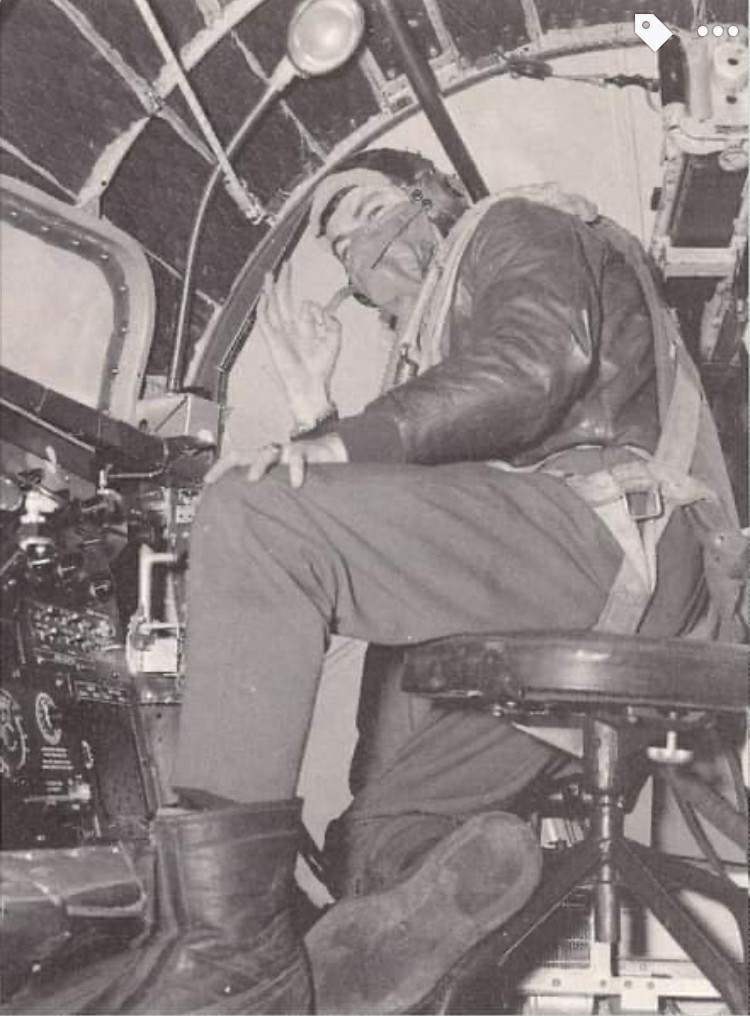
1Lt. Samuel M. Slaton of the 91BG. Note the bombardier’s panel to his left.
While the controls for his panel are different than those of Lucky Thirteen, virtually everything else aboard the nose compartment in this photo is identical.
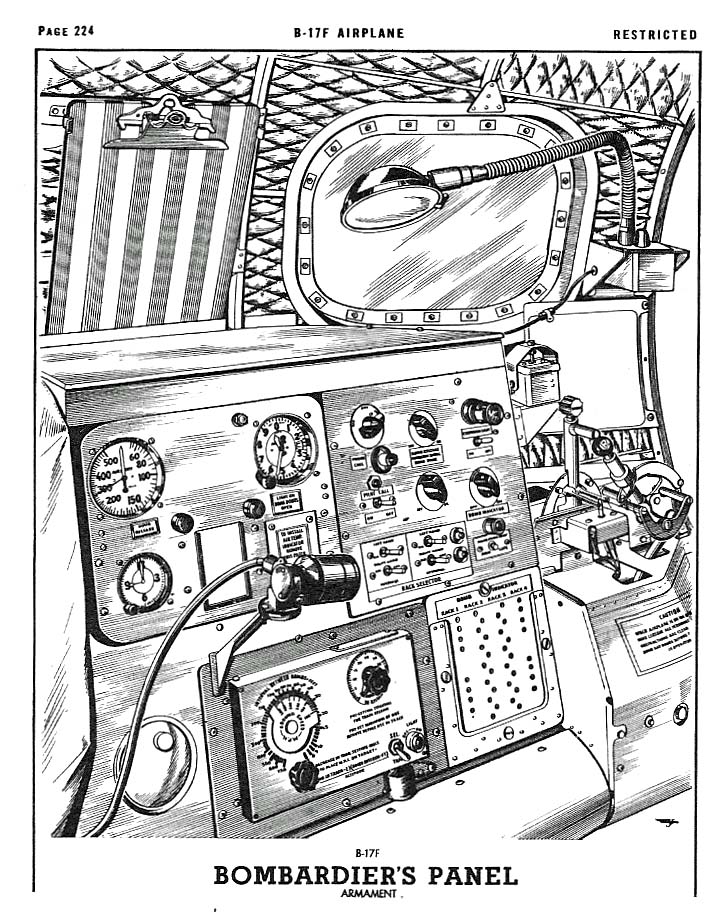
Manual illustration of the bombardier’s instrument panel aboard a Boeing B-17F.
Here you can see the various subassemblies of the panel, including:
-The gauges which repeated information from the cockpit.
-The intervalometer, which set the number of milliseconds between each bomb’s release (in the process setting distance between bomb impacts)
-The rack indicator, which showed which hard points were currently holding bombs.
-The ash tray and the bomb ‘pickle switch’ (for manual release should the Norden bombsight not be used.
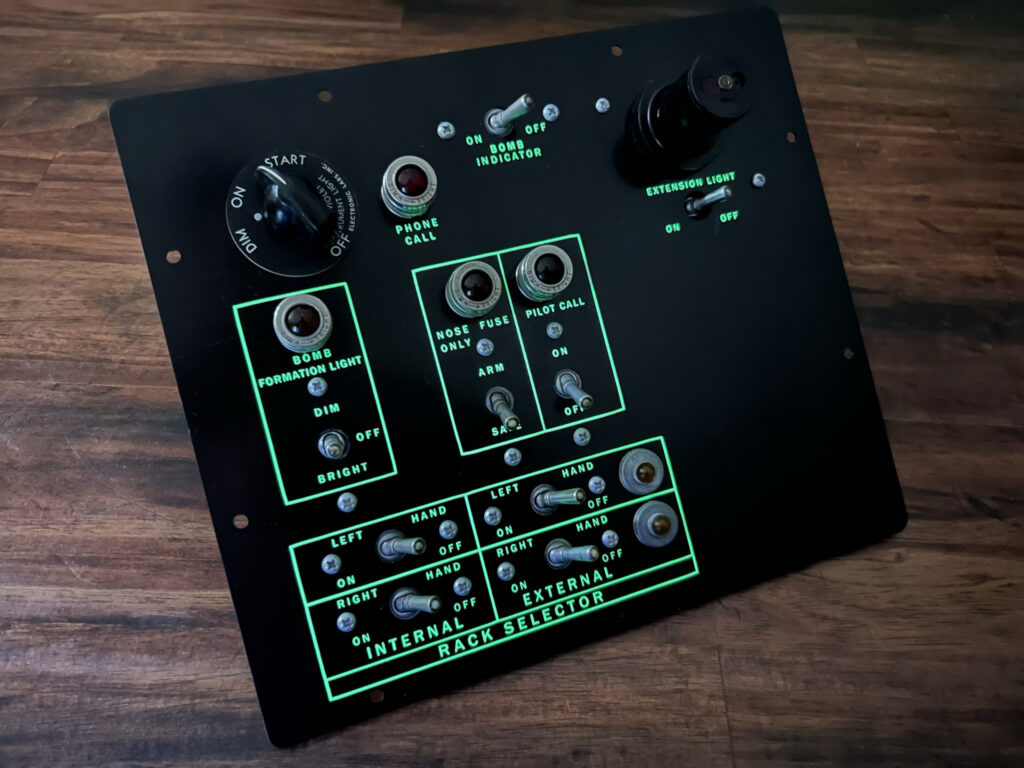
An ultraviolet light is used to showcase the phosphorescent markings on the control panel.
Special thanks to Avery Schroeder of DryTransfer.com for accurately reapplying this unique piece of Second World War history.
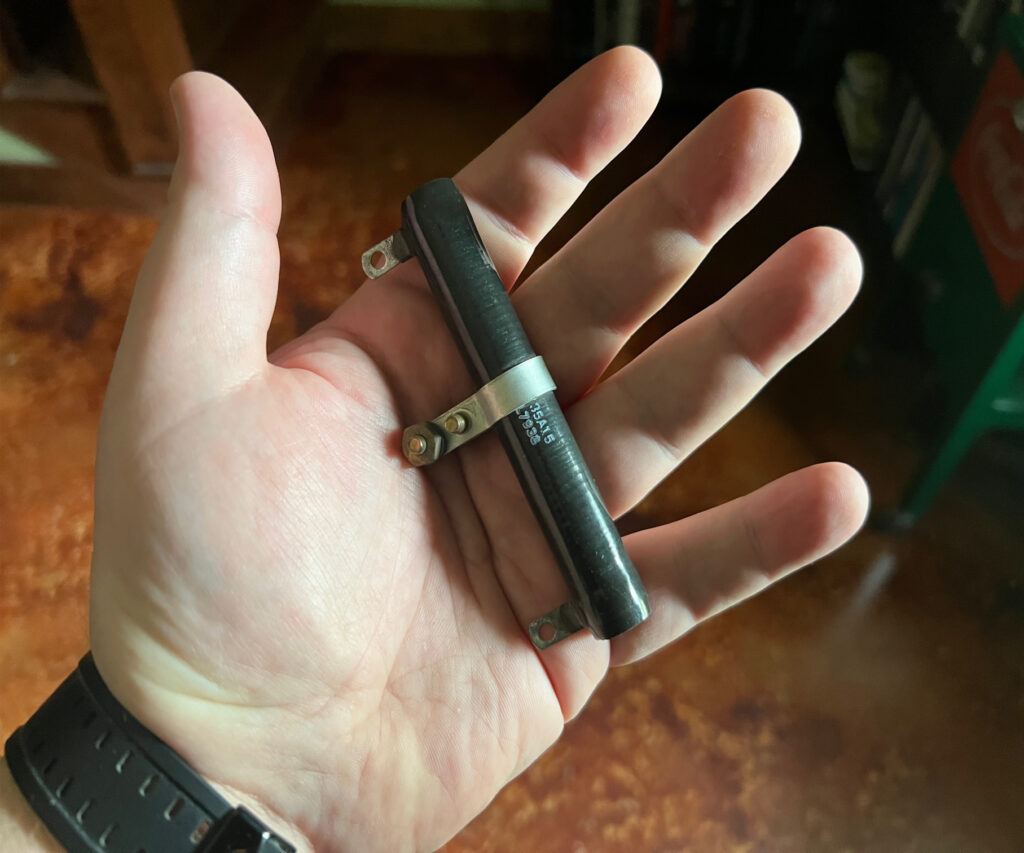
The one piece not attached to the panel is this resistor for the rack indicator lights.
The blueprints call an AN520 screw which measures just over 4 inches in length – an aircraft machine screw size that seemingly nobody has.
Photo taken 1 August 2023.

The Bomb Rack Indicator Panel for Lucky Thirteen.
The spring contracts which run the wires to power these lights appear to no longer be available. As such, volunteer Bill Winter of Charlotte, North Carolina is working to replicate these pieces.
If anyone out there dabbles in metal fabrication, we could use someone to recreate the sleeve assembly which holds these lights… 😉
Photo taken 8 April 2023.
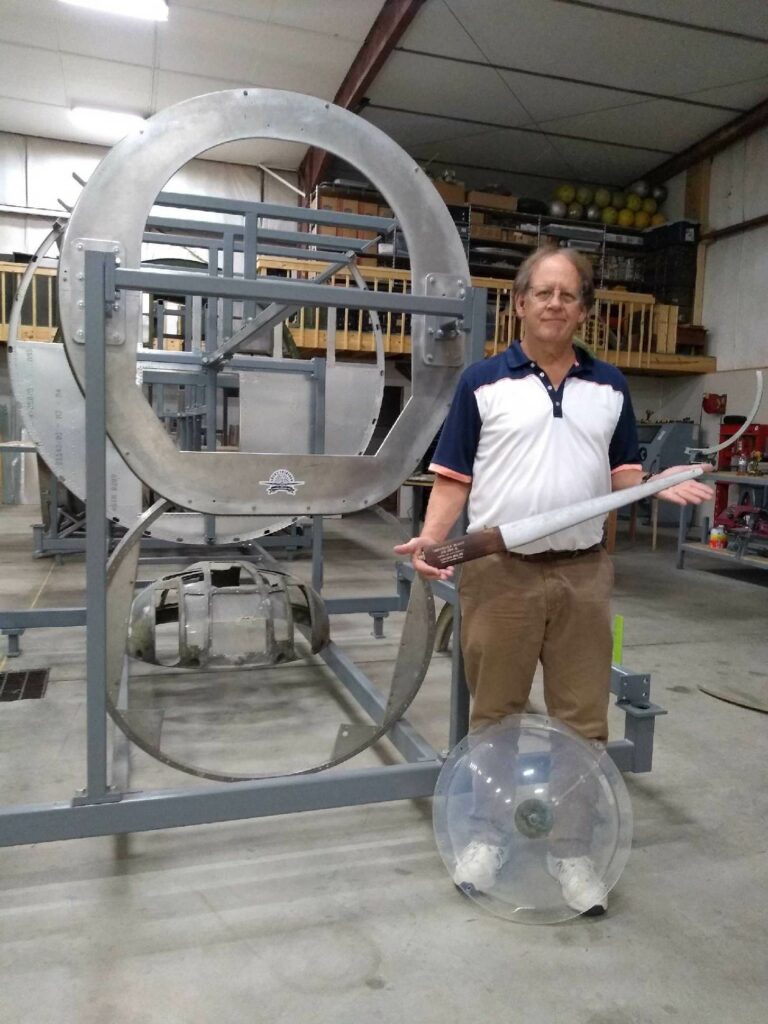
Bob Dicey poses with his newly-donated astrodome and VHF antenna beside the forward jig for Lucky Thirteen.
Photo taken 27 July 2023.
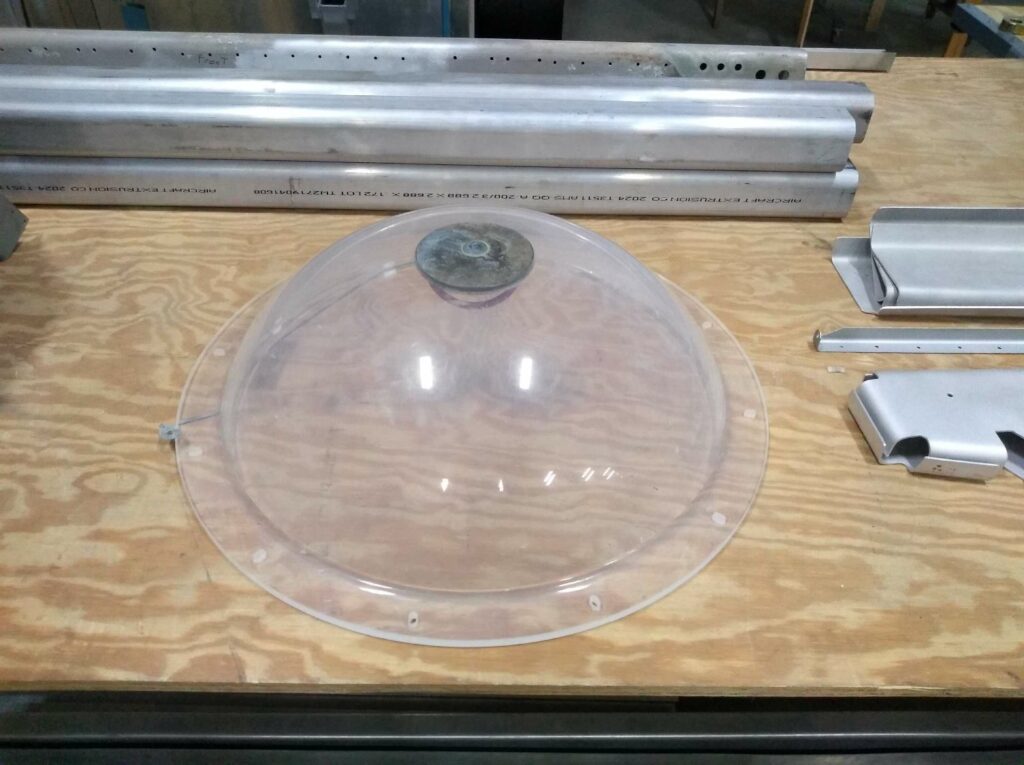
The newly donated 42D5467 astrodome for Lucky Thirteen.
Photo taken 27 July 2023.

42-30663, a Boeing B-17F which never left the United States. Note the astrodome on the nose.
This photo was taken prior to delivery to the Cheyenne Modification Center as this aircraft still lacks cheek guns.
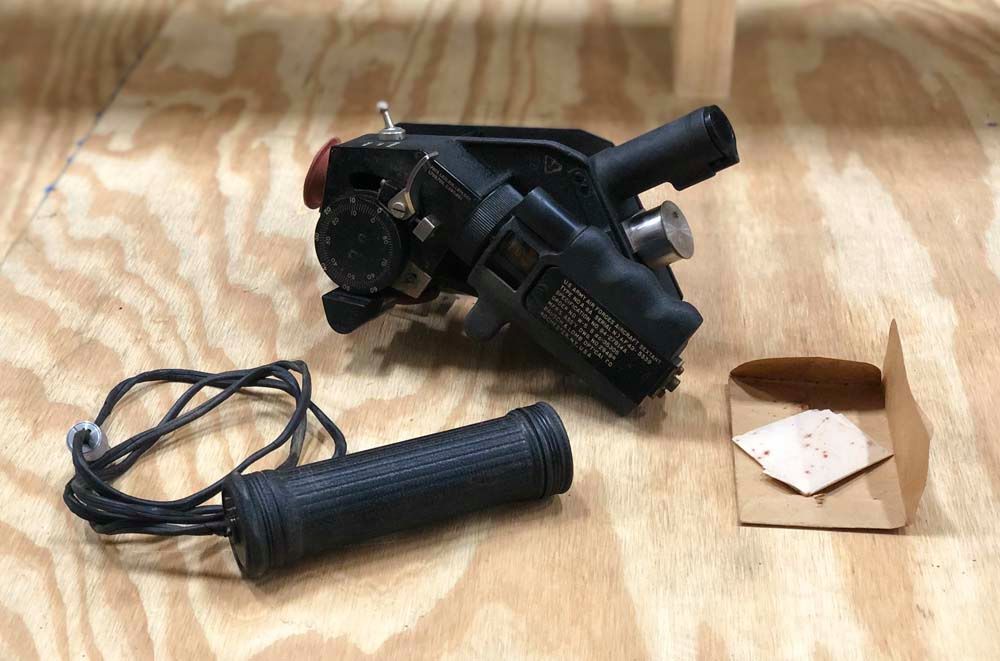
A Bausch & Lomb Type A-8 Bubble Sextant donated to the project by our friend Andy Rivera.
Photo taken 26 October 2019.
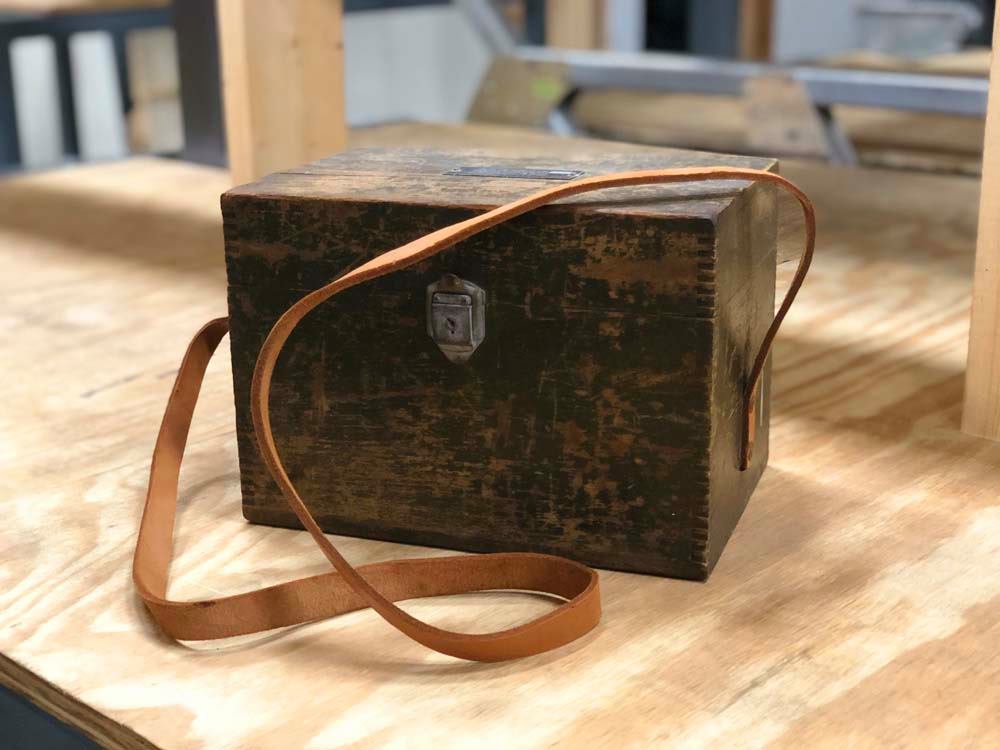
The Bausch & Lomb Type A-8 Bubble Sextant in its original carrying case. While the wooden case has lost much of its finish, the leather strap is in surprisingly good shape.
Photo taken 26 October 2019.
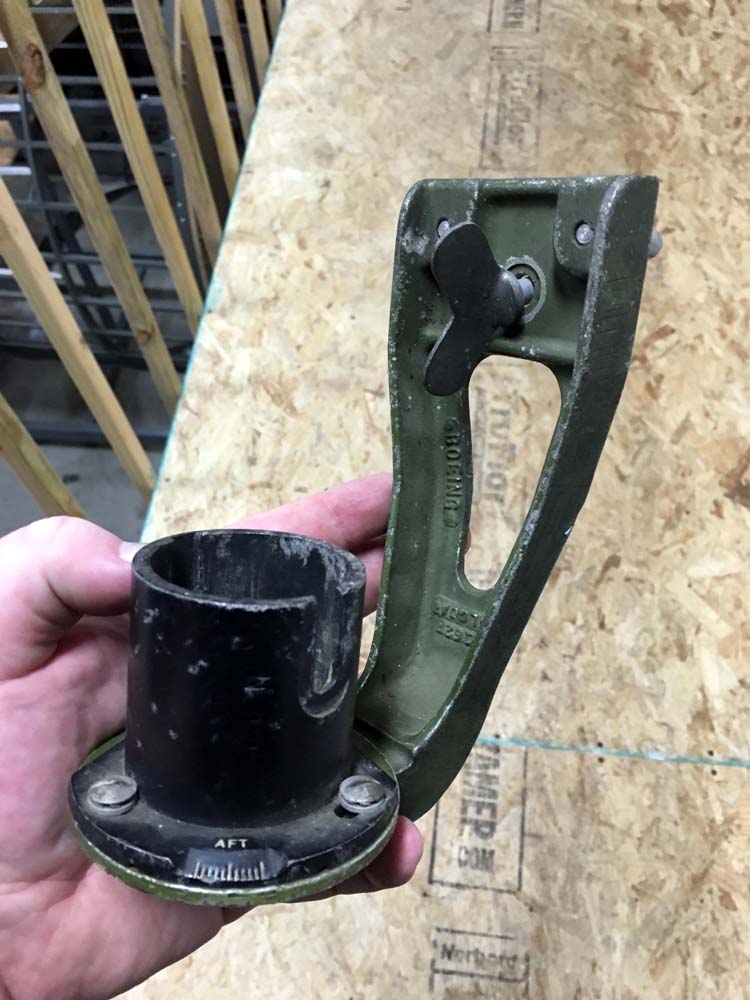
An astrocompass bracket and base donated by our friend Matt Smith of Kettering, England. This bracket came from Grafton Underwood. I.e., this is a 384BG original – the same unit as Lucky Thirteen!
Photo taken 2 July 2020.
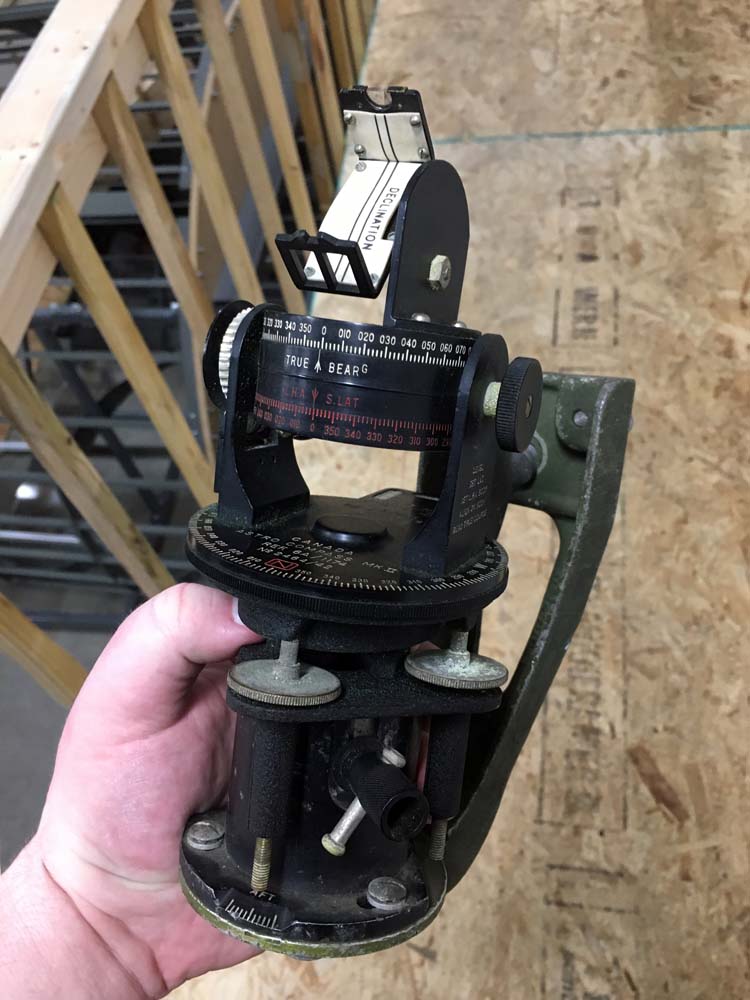
The astrocompasss donated by Andy Rivera is mounted to the bracket and base donated by Matt Smith.
Photo taken 2 July 2020.
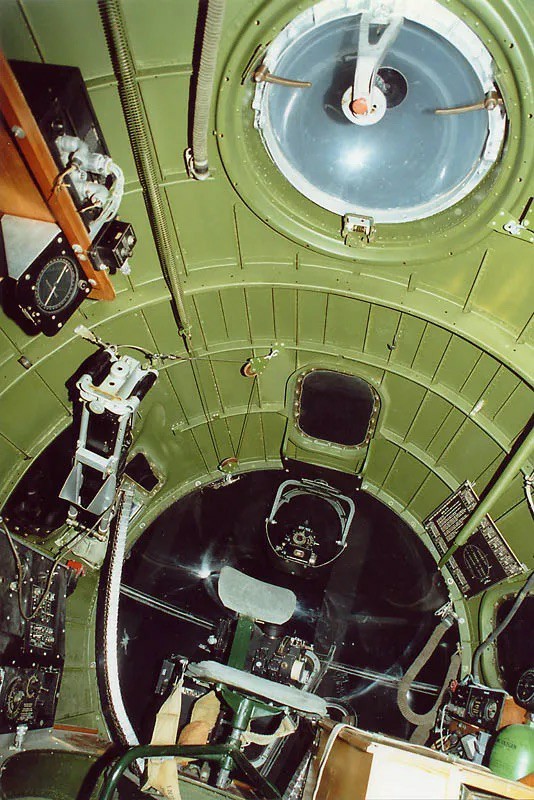
A unique photo taken aboard 44-83735 at the American Air Museum in Duxford, England which showcases the bomber’s astrodome.
The astrocompass bracket can be seen here, along with it release handles and hinge assembly.
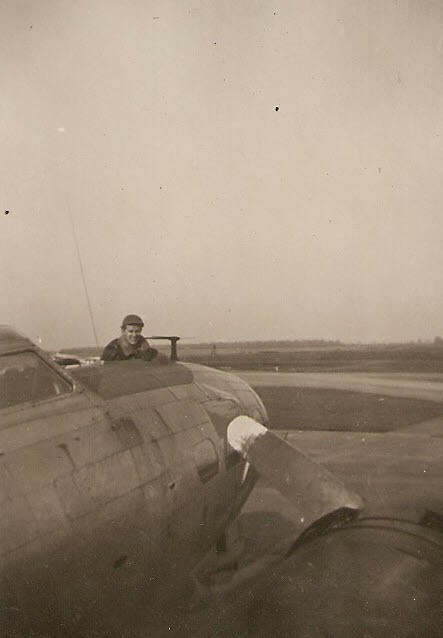
SGT Robert S. Tucker stands in the nose of a Boeing B-17 undergoing repairs at the 2nd Strategic Air Depot.
The astrodome has been folded in for the photo.

Bill Dicey’s newly-donated AN-104-A VHF Antenna.
These antennas came in three variants: Army, Navy, and replacement. The “-A” suffix indicates that this is an Army-issue unit.
Photo taken 27 July 2023.
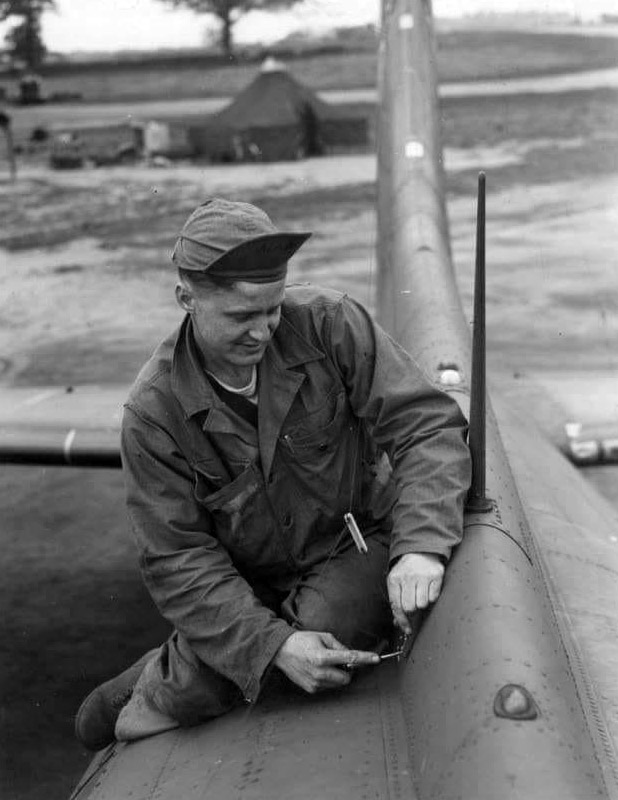
SSGT Roland Downs adjusts the VHF radio mast on Heaven’s Above (42-97328, 388BG).

Knockout Dropper (41-24605, 303BG) taxis to hardstand on 13 November 1943.
Her VHF antenna is visible center fuselage, left of the radio hatch gun.
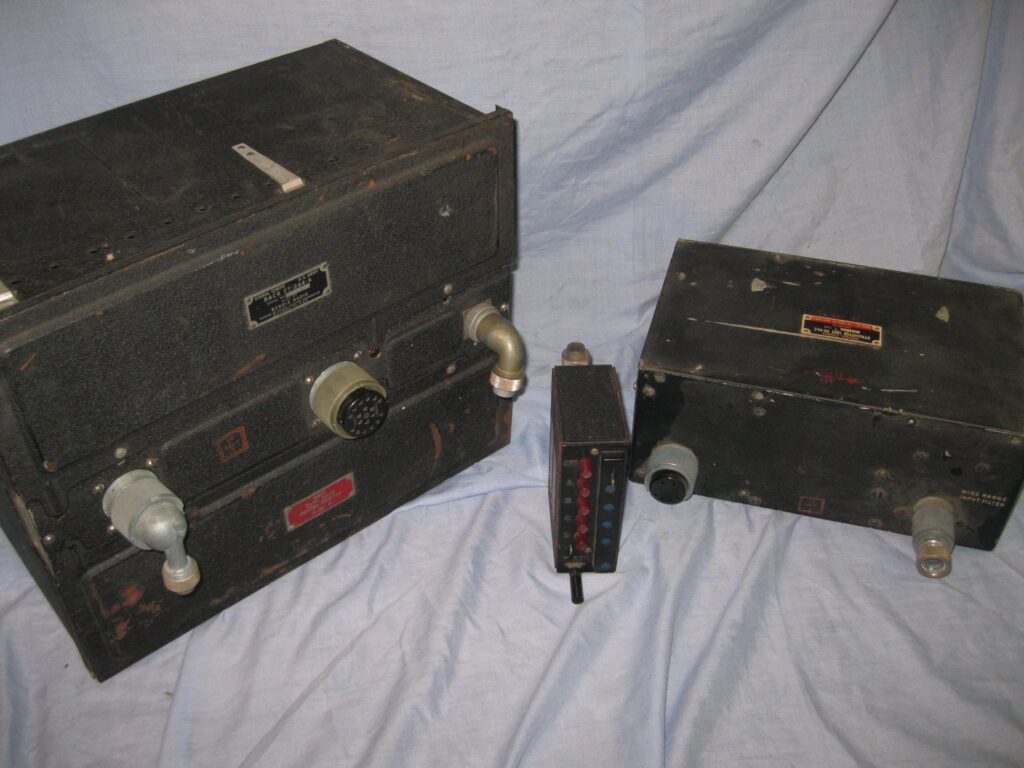
The SCR-522 VHF system for Lucky Thirteen.
On the left is the CS-80 case, which contains the BC-624 Receiver and BC-625 Transmitter. On the right is the radio’s PE-94 Dynamotor.
In the center is the BC-602 Control Box. Mounted in the cockpit, the box has switches for four channels. Usually “A” channel was used for inter-aircraft communication, “B” channel for traffic control, “C” channel for homing stations, and “D” channel for direction finding.
Photo taken 3 January 2019.
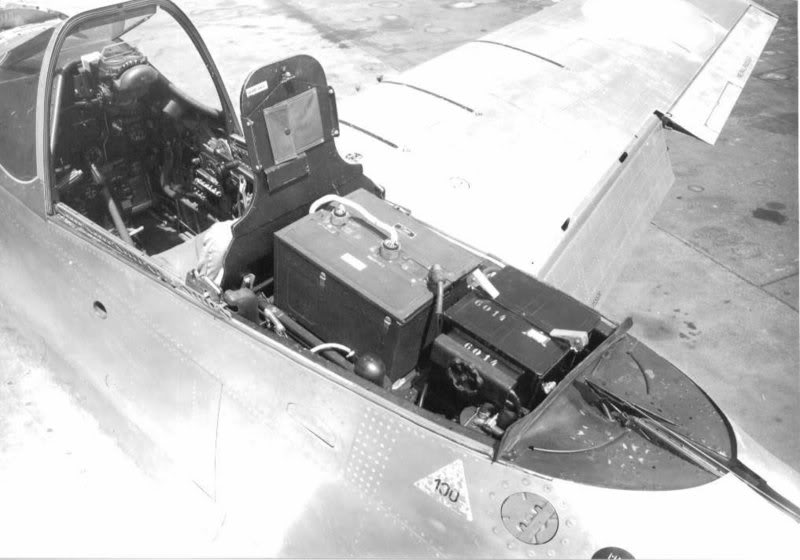
The SCR-522 was common on US fighters in the European theater, and was particularly visible on North American P-51s.
The VHF radio’s transceiver can be seen here just behind the pilot’s armor seatplate.
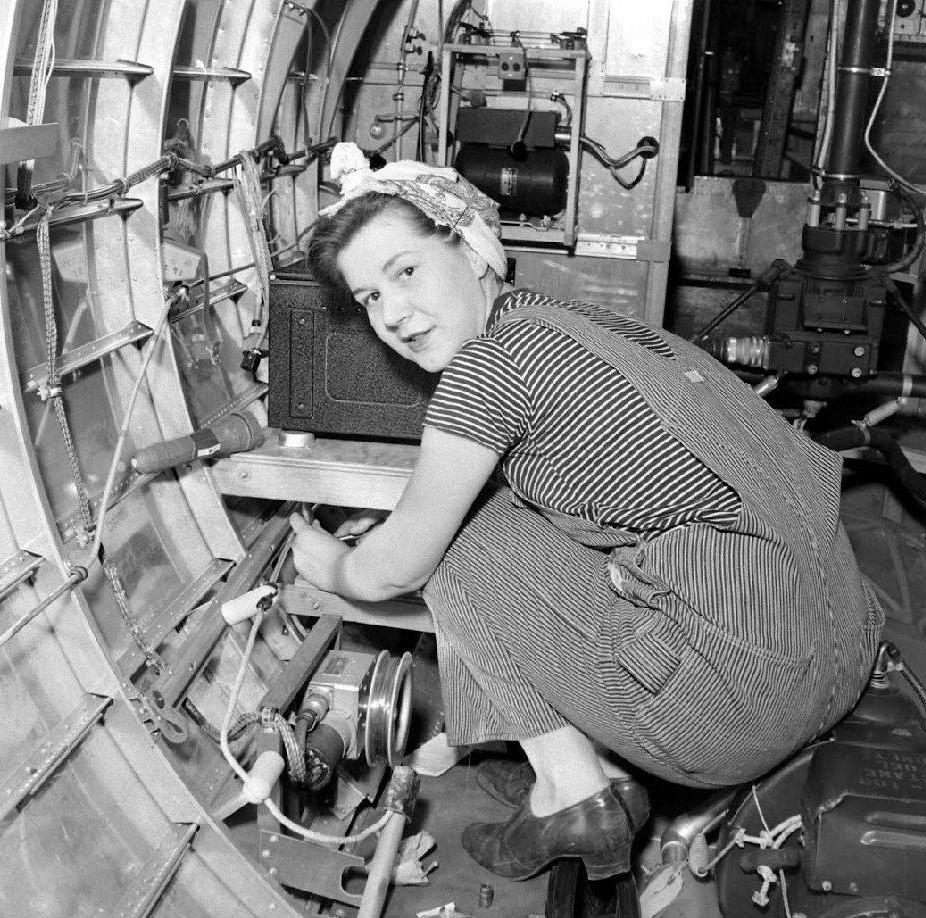
An employee of the United Airlines Modification Center in Cheyenne, Wyoming installs the SCR-552 VHF radio shelves aboard Phyllis (42-97825).
The upper shelf held the transceiver and the lower shelf (which she has her hands in) held the dynamotor.
Note that she is sitting on the HRU-28 Auxiliary Power Unit, which has yet to be installed.

A manual illustration of the SCR-522’s transceiver installed in the camera pit of a late-B-17G.
This installation is applicable to all surviving B-17Gs today except Shoo Shoo Baby (42-32076, 91BG).
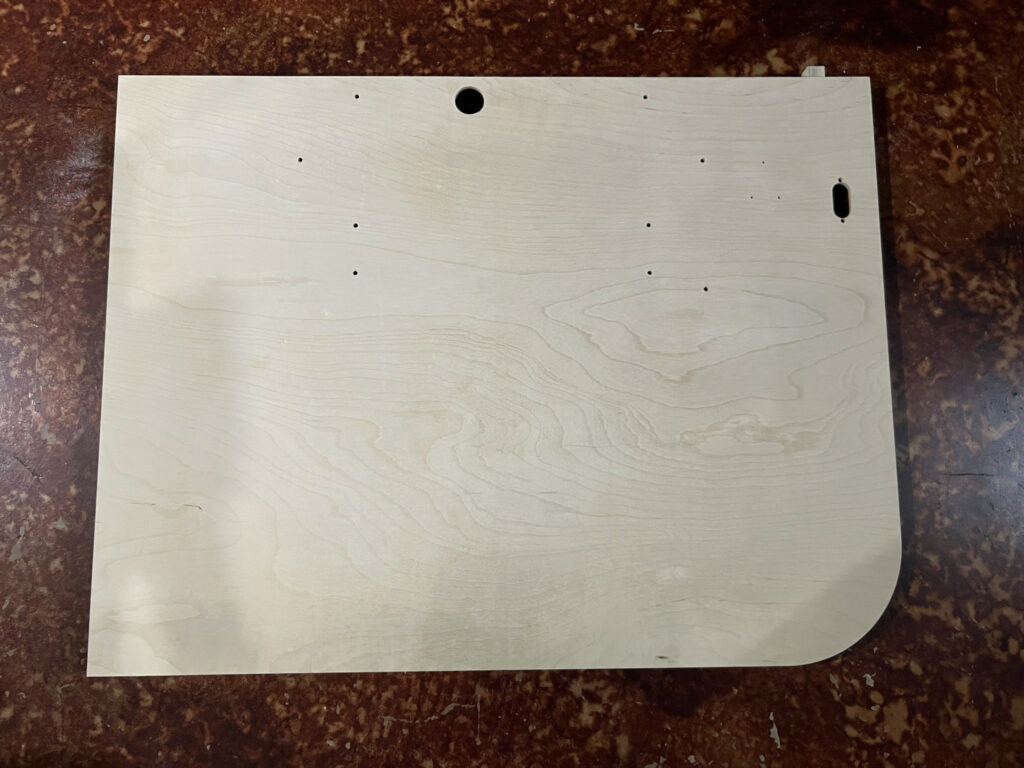

The newly fabricated radio operator’s table for Lucky Thirteen, awaiting its bronze green paint job.
Photo taken 1 August 2023.
